Rickubis Bird Page #10:
Bitterns!
This
page was born 07/08/2015. Rickubis designed it.
(such as it
is.) Last update: 3/23/2024
Images
and contents on this page copyright ©2002-2024 Richard M. Dashnau
Go
back to my home page, Welcome
to rickubis.com
Go
back to the RICKUBISCAM
page.
----------------------------------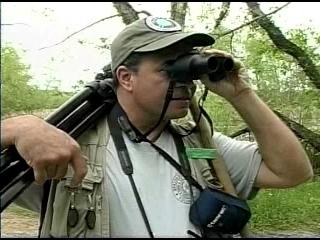
Welcome
to Brazos Bend State Park. That's me on the trail. One of the most
popular
reasons for people to visit BBSP is to see the birds. Although I
started
going to the
park mainly for the alligators, one cannot be there for long
without learning to enjoy the birds. Over the years, I've captured a
few
pictures and video clips of them, and
over
that time, I have gathered enough material on some species to give them
their own page. So...here are the Bitterns. The latest observations are
at the top, and
scrolling down will send you back in time--to the earliest one in 2002.
03/03/2024
Brazos Bend State Park I was near the pod of baby
alligators south of the Spillway Trail (that I had been watching since
the summer before),
when I heard an American Bittern (Botaurus lentiginosus)
call from right behind me-on the North Side of the trail. It only
called once, but the call was easy to recognize. After
a careful
search, I found the Bittern hiding among a small clump of
Giant
Cutgrass. It remained hidden, so I went back to observing the
pod
and discussing it with visitors.
The Bittern moved until it
was a bit easier to see, so I pointed it out to a group of visitors,
and did my impression of a Bittern call. My impression wasn't very
good, but
illustrated how weird the call was. I could tell
by the quizzical expressions on the faces of some of the visitors. But
then, a few minutes later the Bittern actually called--only
once, but enough for us all to hear it. Over
the next few hours, the Bittern moved out of one clump of grass,
through some bare scrub, over the old alligator nest mound,
and into
another small clump of grass.
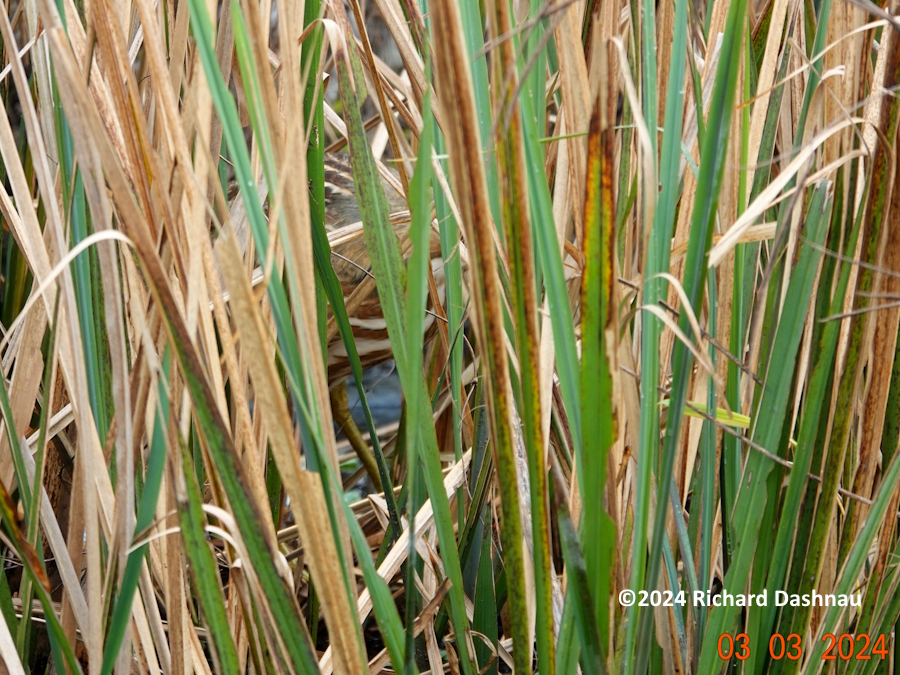
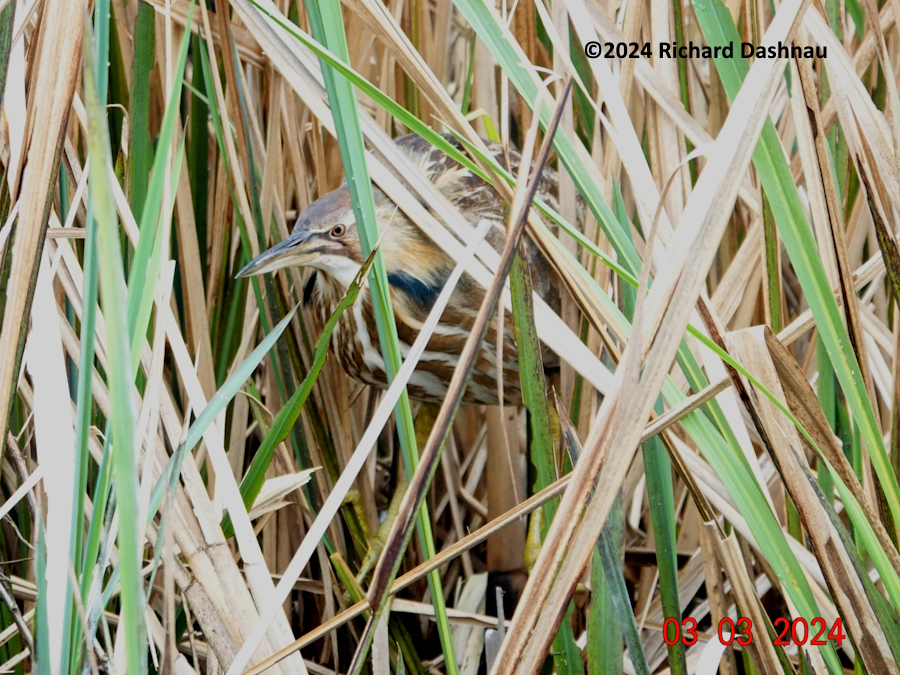
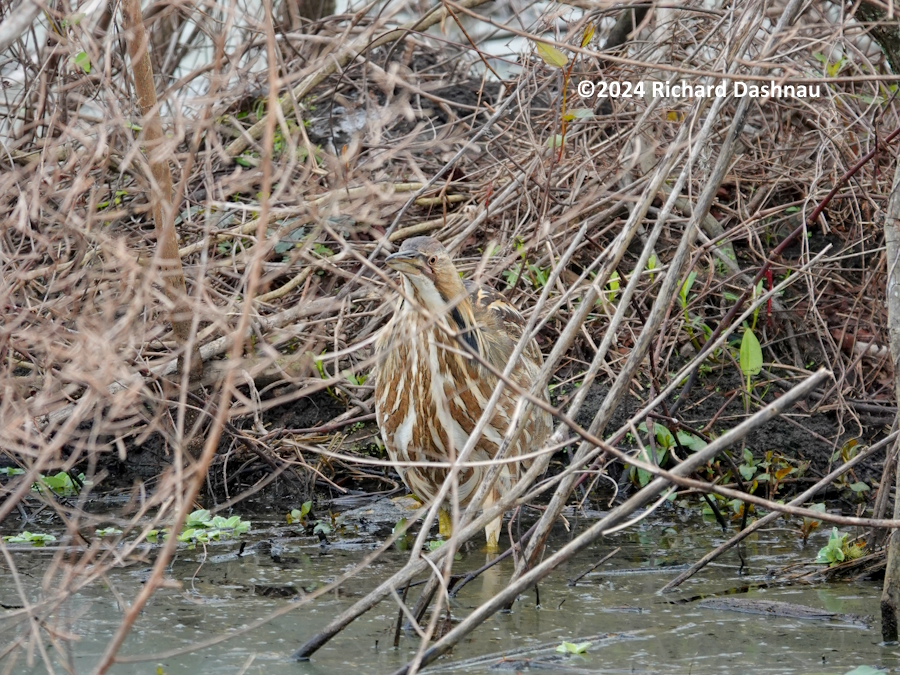
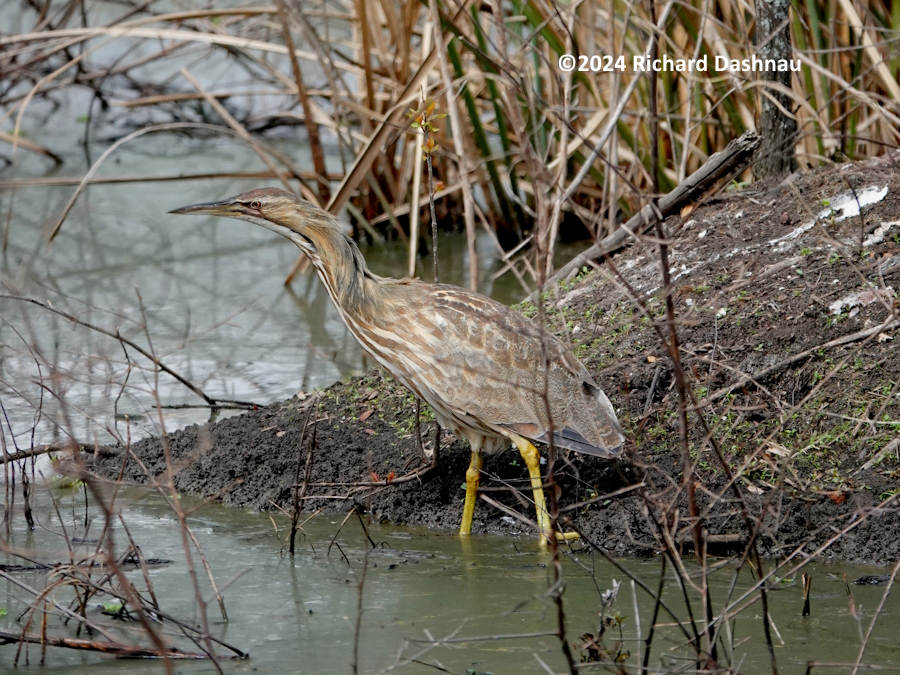
I
only have a few images of this Bittern, and no video. This
relatively bare sighting inspired me to revisit some of my old Bittern
images and video clips from 2015 (they're
further down on this same page); and also to do more research
about how Bitterns make that odd call.Today's photos also show how the
colors of the Bittern work with
various
backgrounds as it walked out of the grass, through other
plants, and
into another patch of grass. The plants in the area of Pilant Lake
from the West bank, and
along the Spillway Trail East changed a lot
when it all dried completely in 2022. The Giant Cutgrass
(and
other plants) that had been there appeared dwindled in the
dryness in
2022. Spring and Summer of 2023 were almost as bad.
The grass is
almost entirely gone from that area and I believe that the
Bitterns no longer find enough
cover (and maybe enough food) to visit
there as often as they used to.
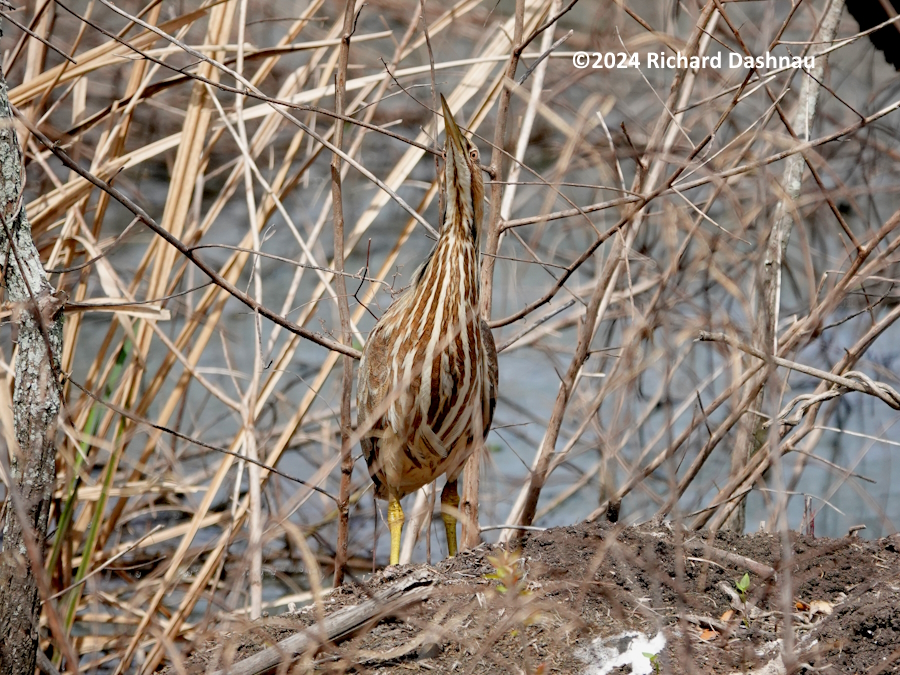
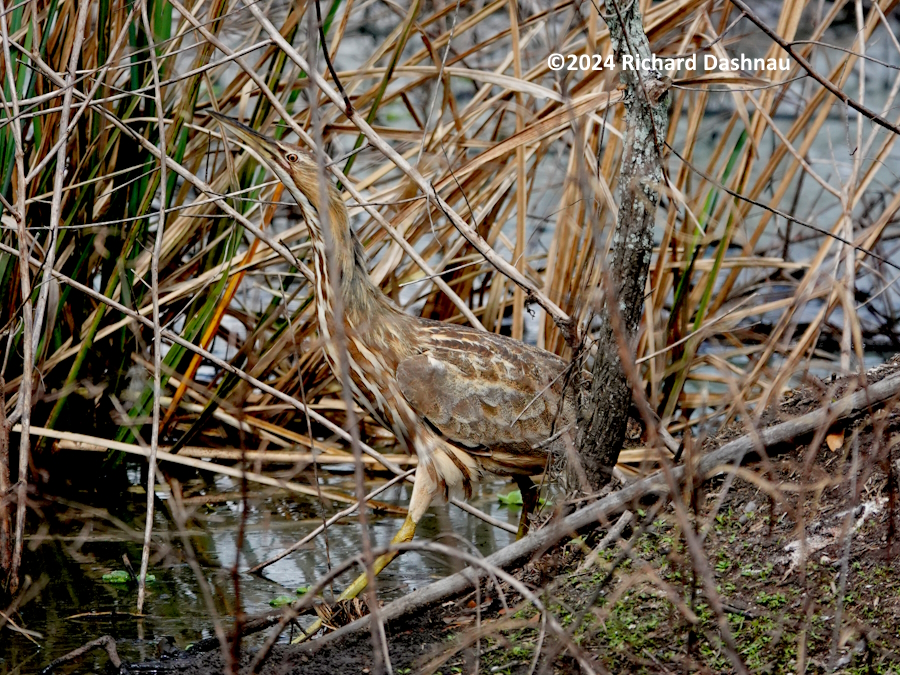
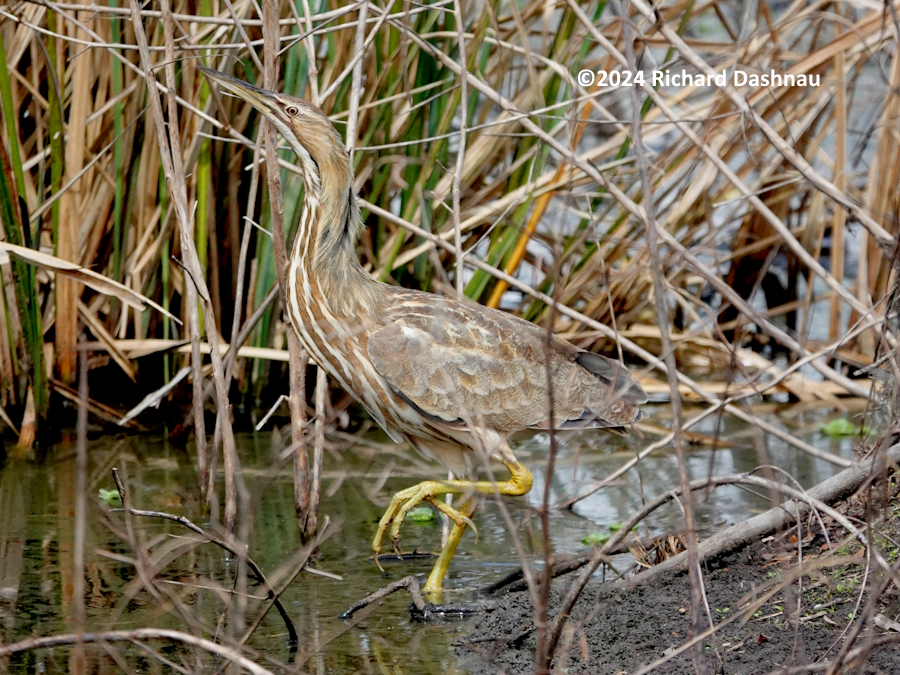
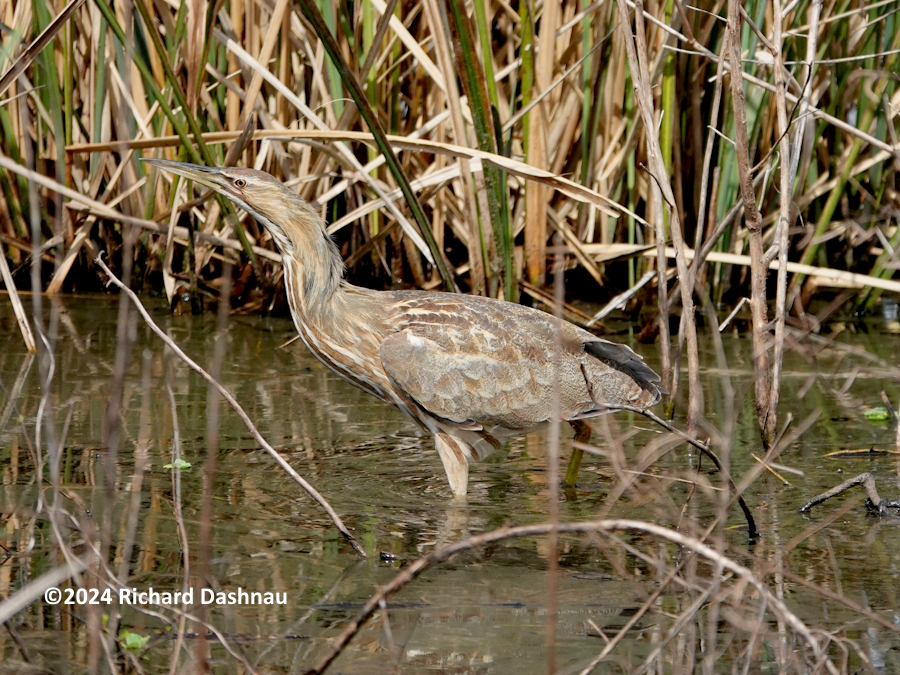
I've
found two sources that gave me some very interesting concepts related
to Bitterns and other birds: #1. " The Function of the
Oesophagus
in the Bittern's Booming"
by James P. Chapin (1922) and #2. "Coos,
booms, and hoots: The evolution of closed-mouth vocal behavior in
birds" by Tobias Riede, Chad M. Eliason, Edward H. Miller,
Franz Goller, and Julia A. Clarke (2016)
(Chapin
1922) described "two curious elongated pads" on the inner surface of
the joint of the lower mandible (mandibular rami); and guesses that
they may serve as a
plug to keep air in the gullet. They seem to
be temporary structures. Just closing a bird's beak alone wouldn't work
to keep air in the oesophagus, so the extra pads
would be needed.
The conclusion is that the Bittern does inflate its oesphagus, but the
process for doing that is unknown. I made the image below
from
digital models
of
a Eurasian Bittern (Botaurus stellaris) skull
and mandible that I placed together, then took a screenshot--which I
sketched onto. The image has the proper attributions for
the models.
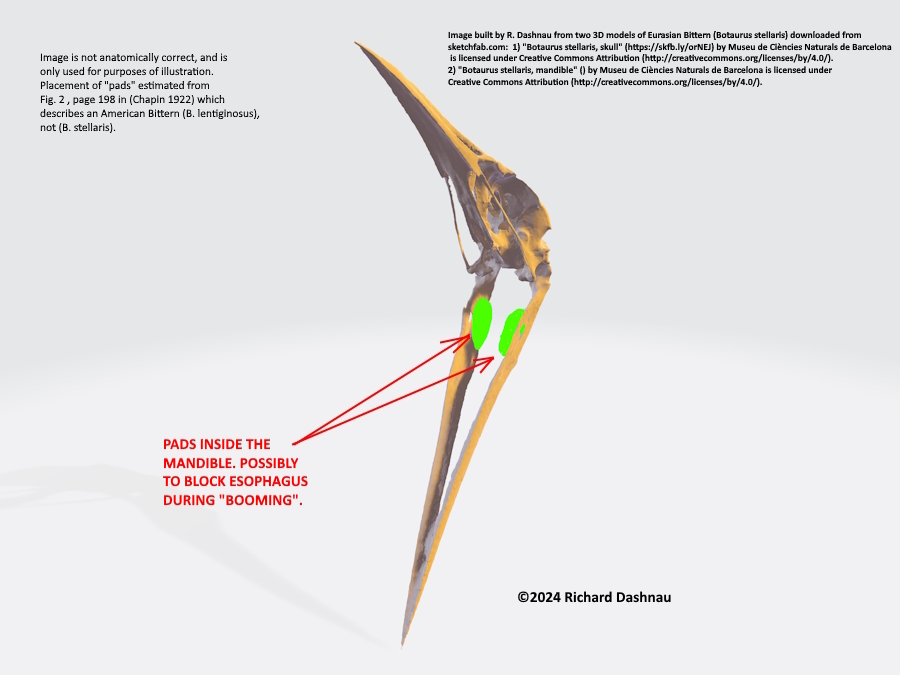
(T.
Reide et. al. 2016) Discusses more about the mechanisms used in
"closed-mouth" vocalization. Most birds call with open beaks. but a few
make sounds with their
beaks closed; and use a bladder, or
something resembling an inflated bladder to modulate the
sound.
Since birds don't have lips, simply closing their beaks won't
produce
a good seal. I haven't seen a discussion of how the seals work exactly,
but the study indicates that in some species (including Bitterns) the
espophagus is inflated.
My video clips demonstrate an American
Bittern call. Until I read the T.Reide study, I hadn't realized that
other birds I have seen would also use a similar method. I've been
standing
near Emus when they made their low rumble. Doves also inflate their
esophagus when they coo. When they exhale, they close the upper throat,
inflate the
esophagus then coo by calling through their syrinx and
modulating the call using the closed, inflated bladder. Such techniques
result in calls with relatively low
"Fundamental frequency".
After
reading all that, I tried to modulate my own voice by making sounds
mouth open, mouth closed, puffing cheeks. Putting air into my esophagus
just allows me
to burp. I can make an interesting grunt with mouth
closed and forcing air "backward" by some kind of throat
movement. I can do it, I've never considered
figuring out HOW. I could produce changes in tone, and also
made my dog look at me like I was crazy.
From BBSP on 06/19/2022 The
water level drop in Pilant Lake has affected all kinds of things. Least
Bitterns-which are usually very shy, and not seen at BBSP very
often-have
been very active. On some weekends, I have seen up to 6 in a
single
day. I believe it's because the water has left from their
usual
hiding/foraging spots, and they have to hunt
the puddles that
remain. The puddles don't offer much cover (since they are
surrounded
by open mud), so we get to see more Least Bitterns.
Green Herons
have also been more common in Pilant Lake along the Spillway Trail, and
probably for the same reason. It's been a great opportunity to witness
both species foraging
side-by-side (or at least within a few yards of each other).
On 6/16/2022 , there were more Least Bitterns out hunting. As
I've mentioned
before, sightings of Least Bitterns are relatively uncommon at
BBS. (there are probably many of them out
there, but they are
secretive). These were all at Pilant Lake, near the Spillway Trail.
They are probably more visible (like many of the other hunters showing
up there) because the depleted
water of Pilant Lake has formed shallow
puddles that contain trapped prey. The first 3 images below show one
of them at various stages of balance on a branch. In the
fourth,
it had
moved to another. The video is here(mp4).
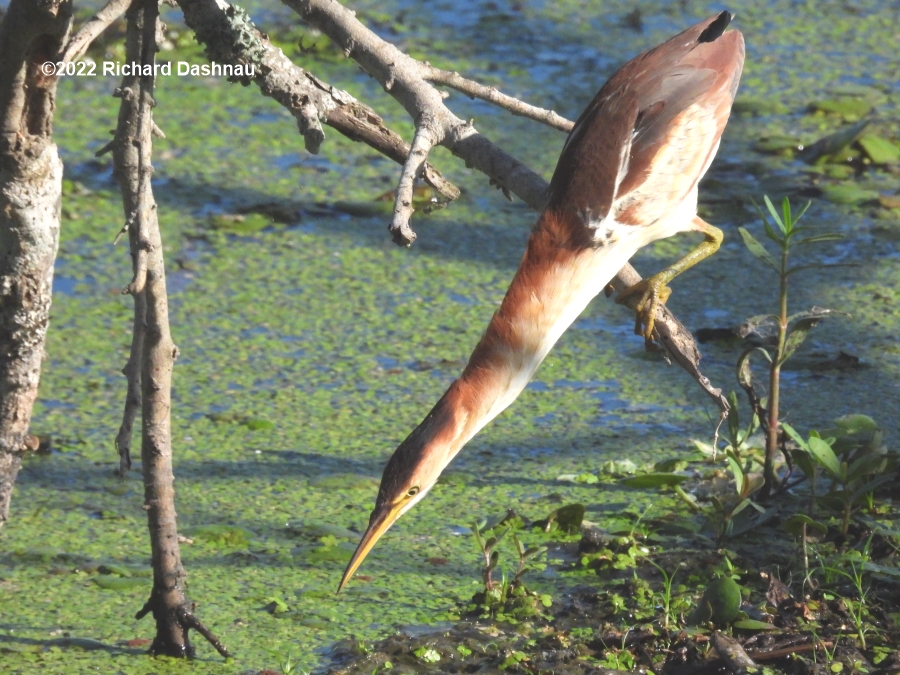
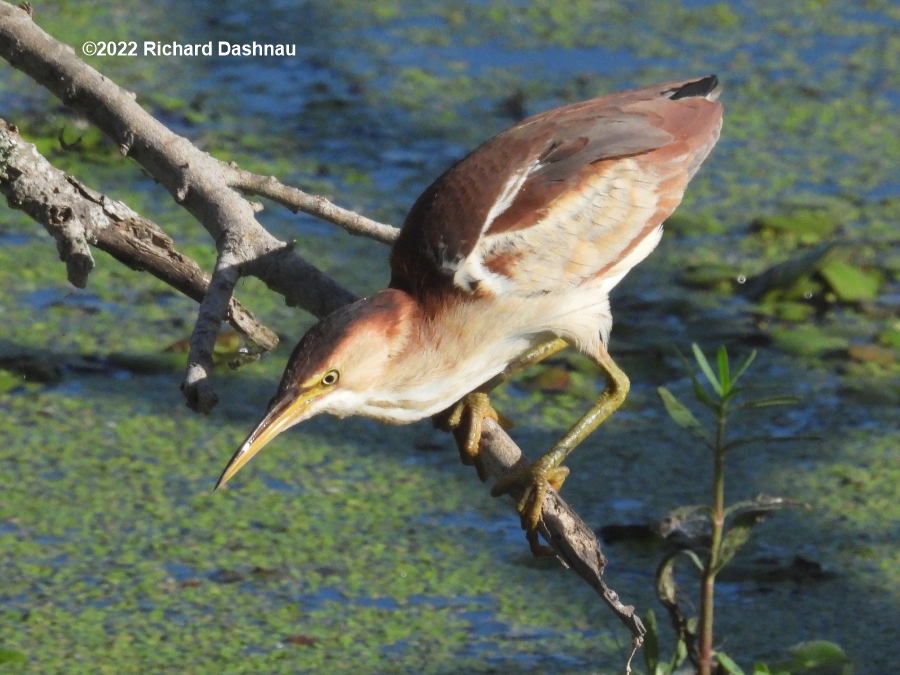
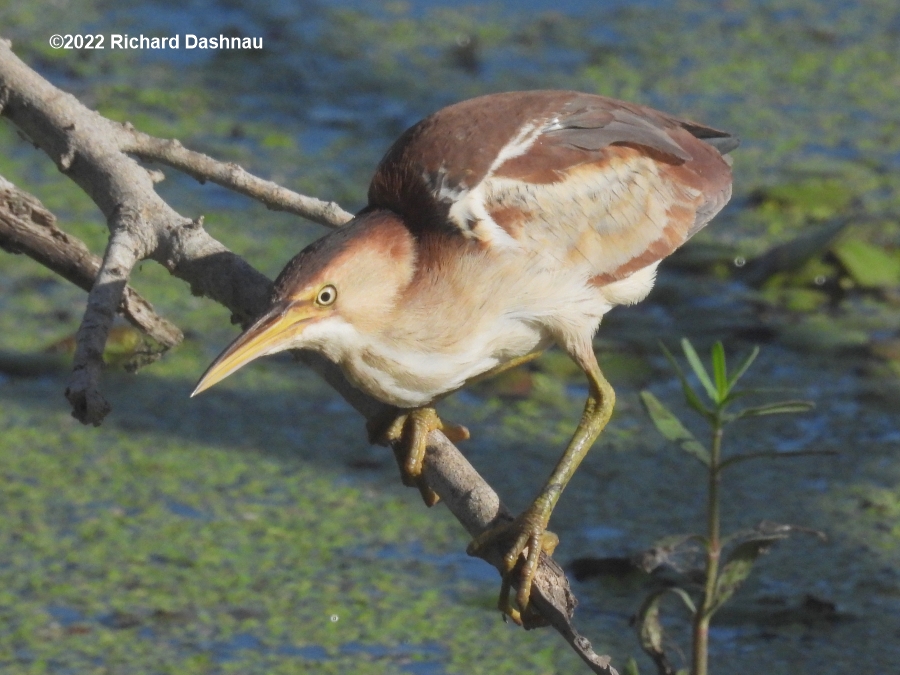
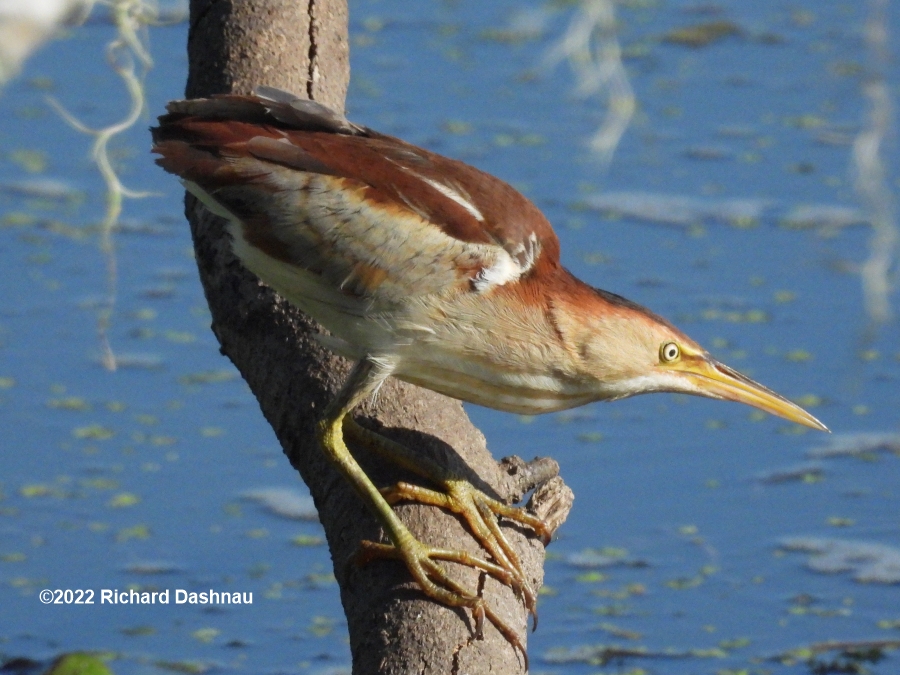
The
4 images below are frames from a video clip of one of them hunting.
These 4 show it targeting, then catching, a fish (there's more than
that in the video.).
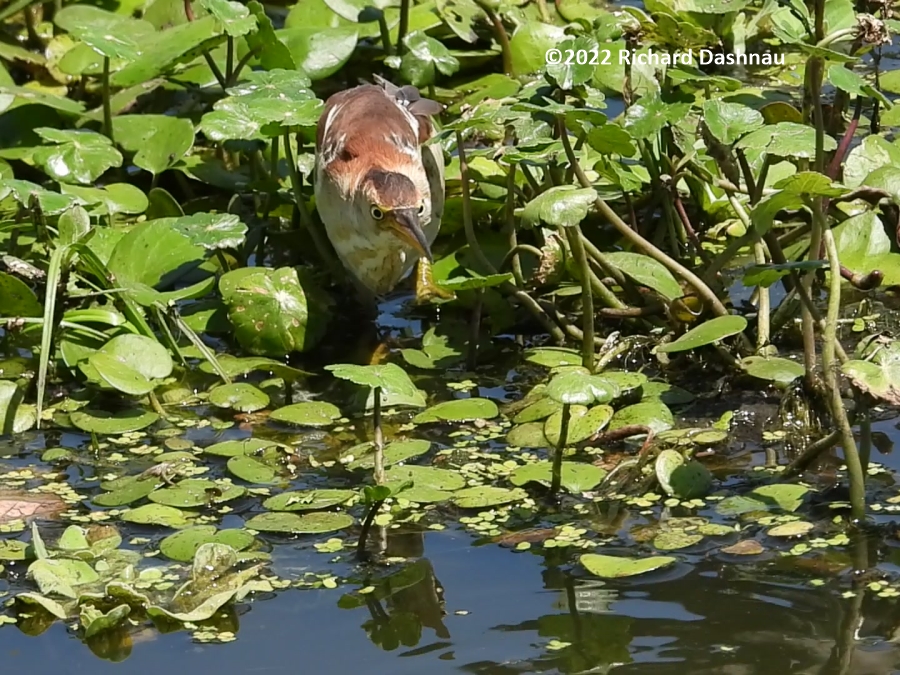
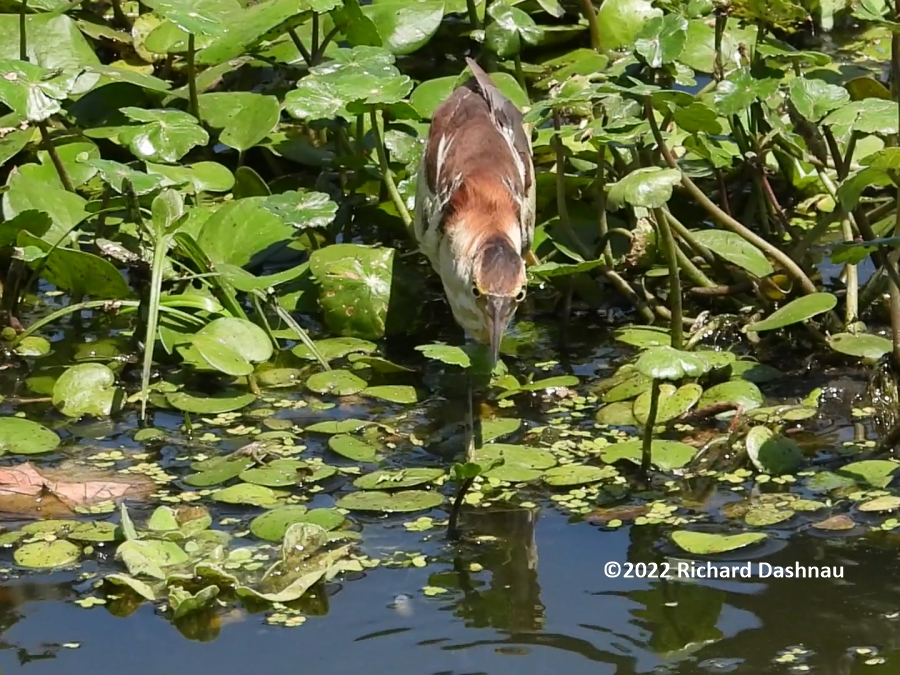
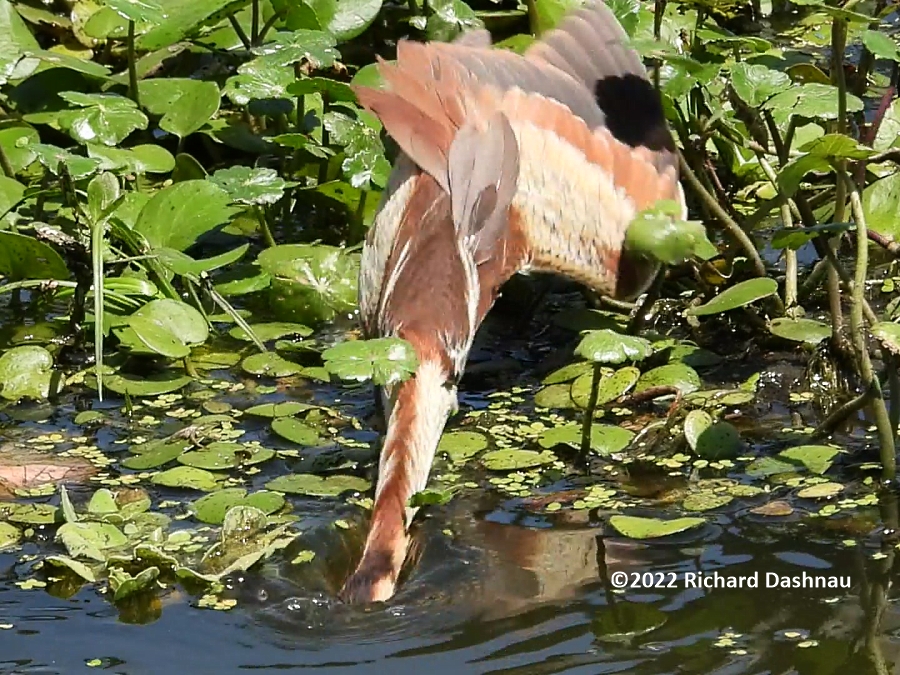
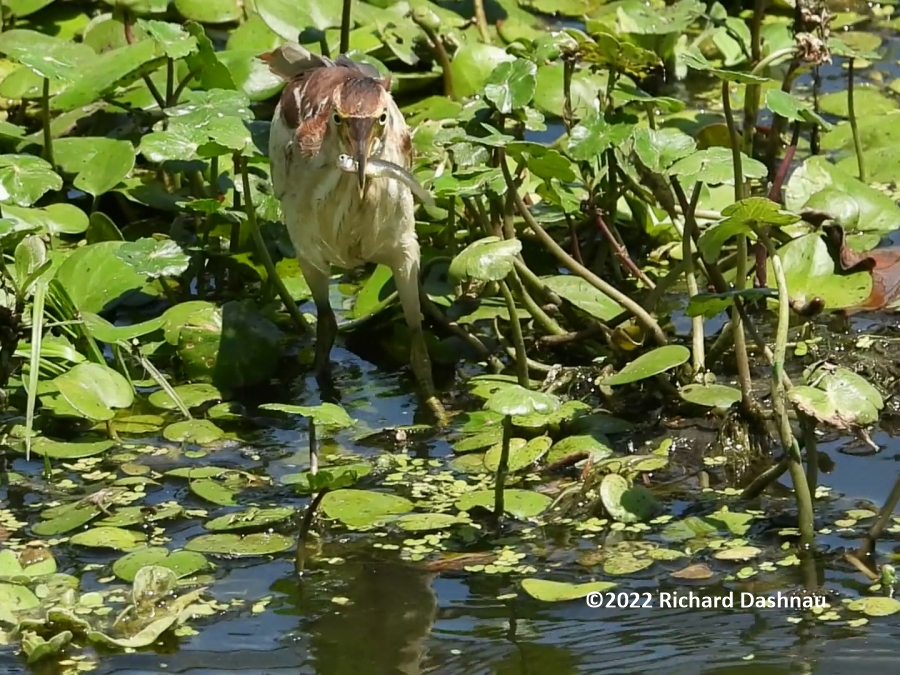
I've
captured some high-frame rate video clips of one of the Bitterns
hunting, too. The sequence below are frames taken from one of the video
clips
that was filmed at 480fps. It shows the
subtle shifts in the Bittern's
position as it finds a target, extends its neck toward it, then leans
forward with its body to prepare for the thrust forward with its
beak. After capturing the fish, it
pulls upward and back, and regains a
compact position. Amazing balance! I've completed the
slo-motion video. The HFR video is here(mp4).
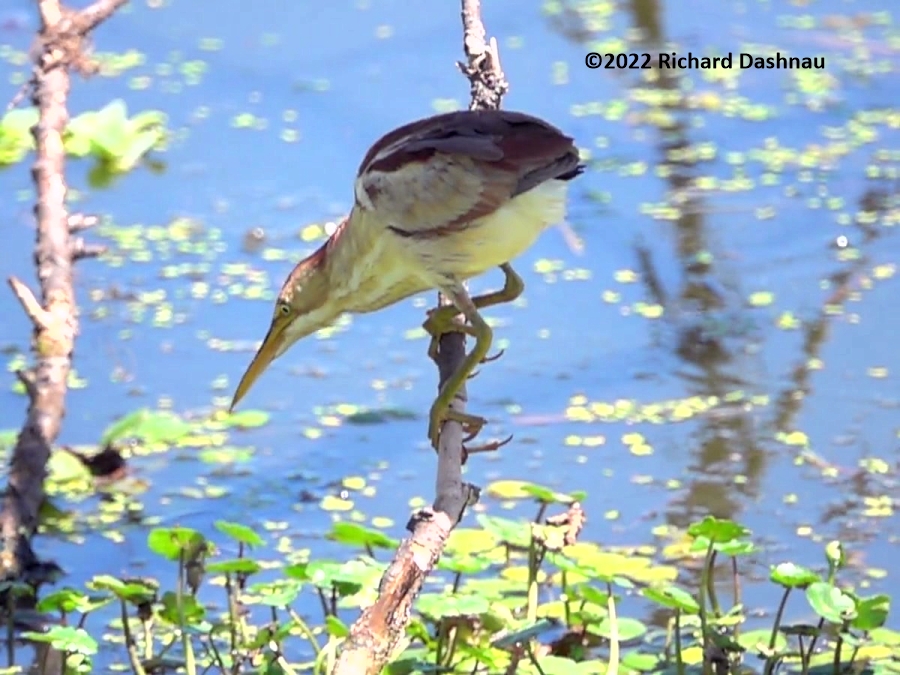
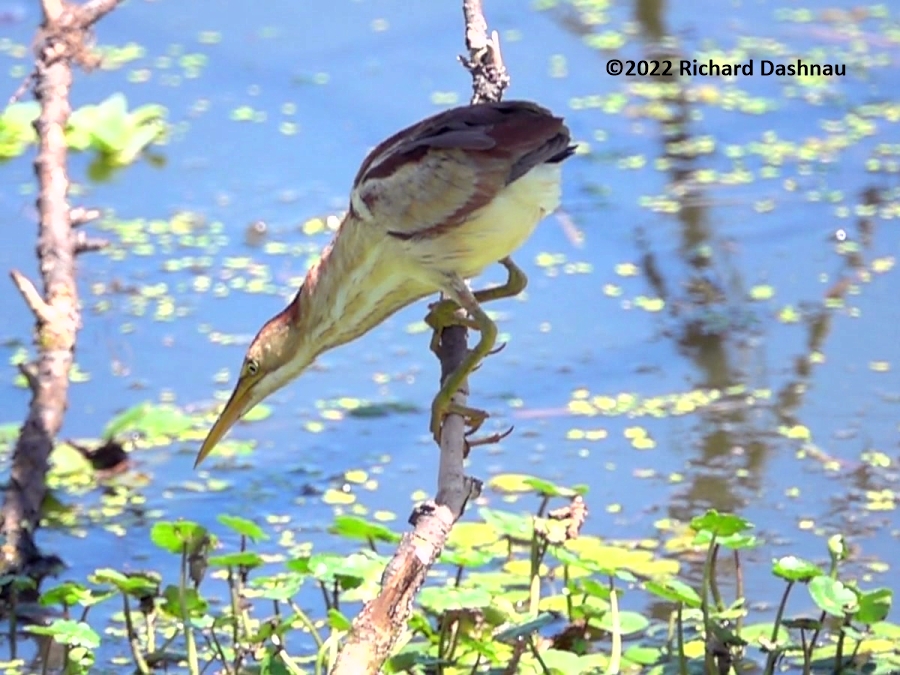
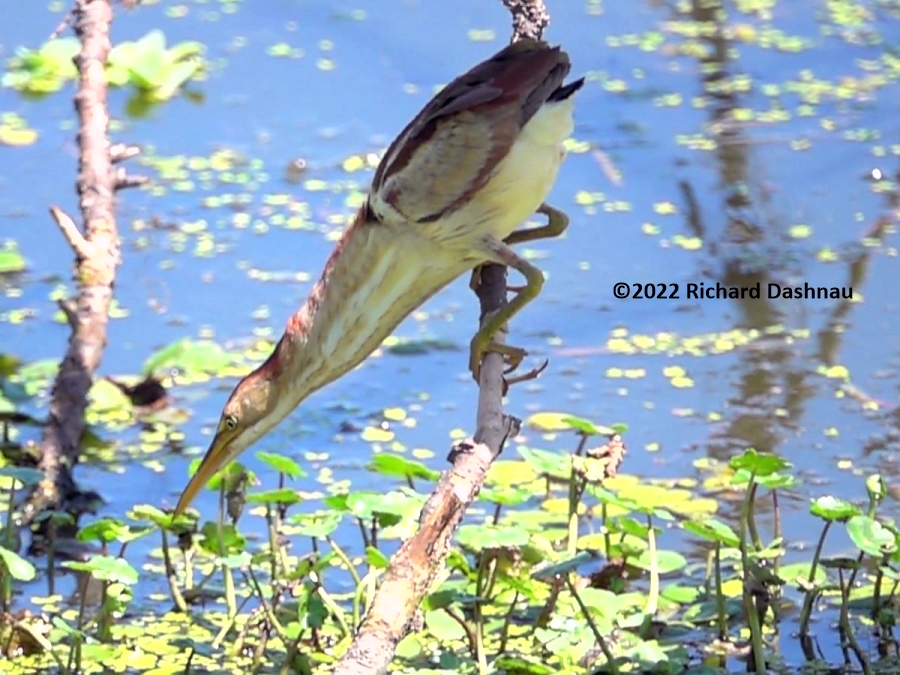
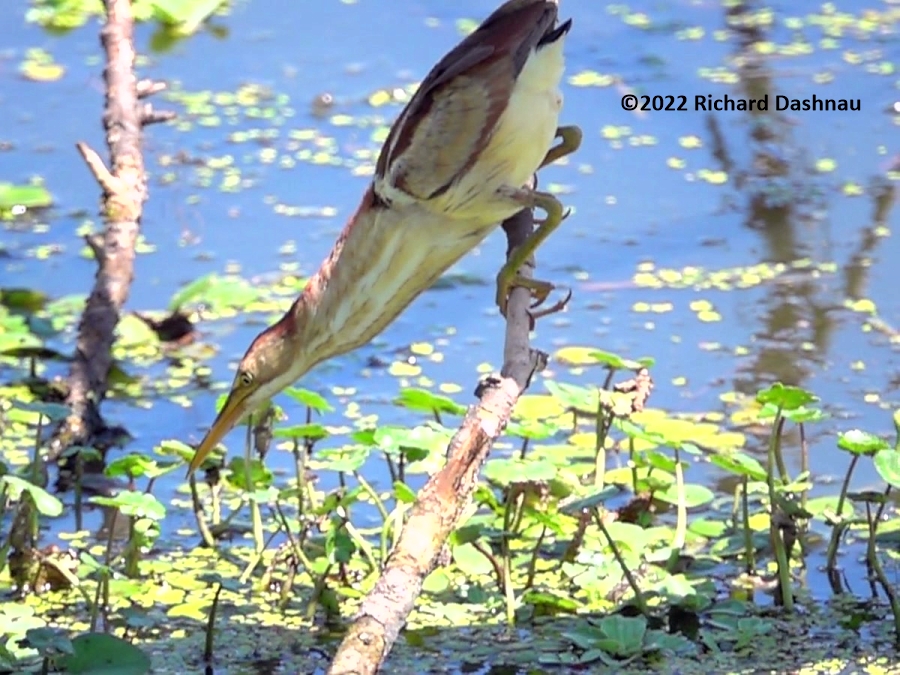
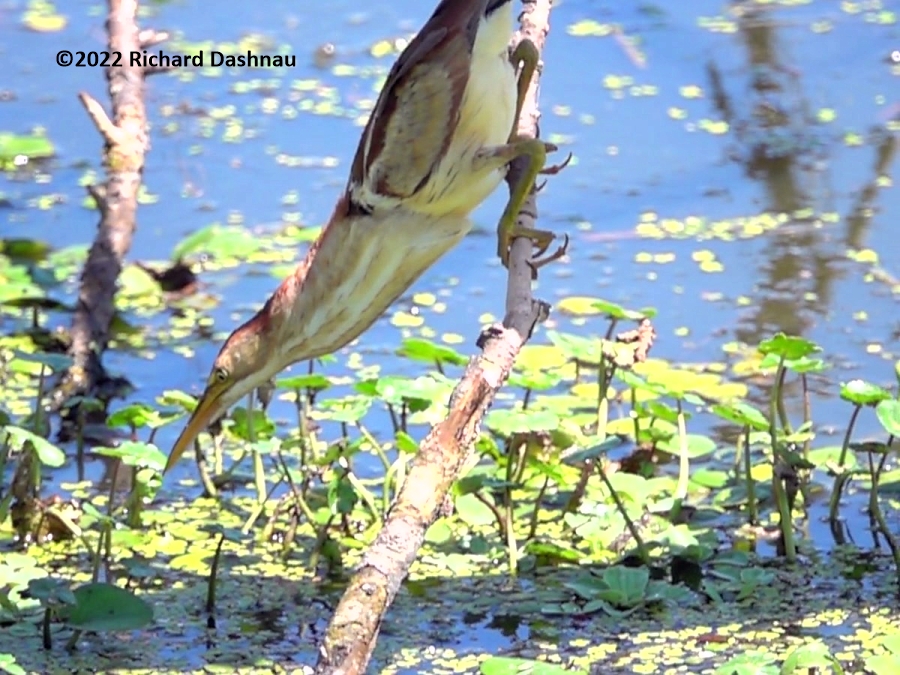
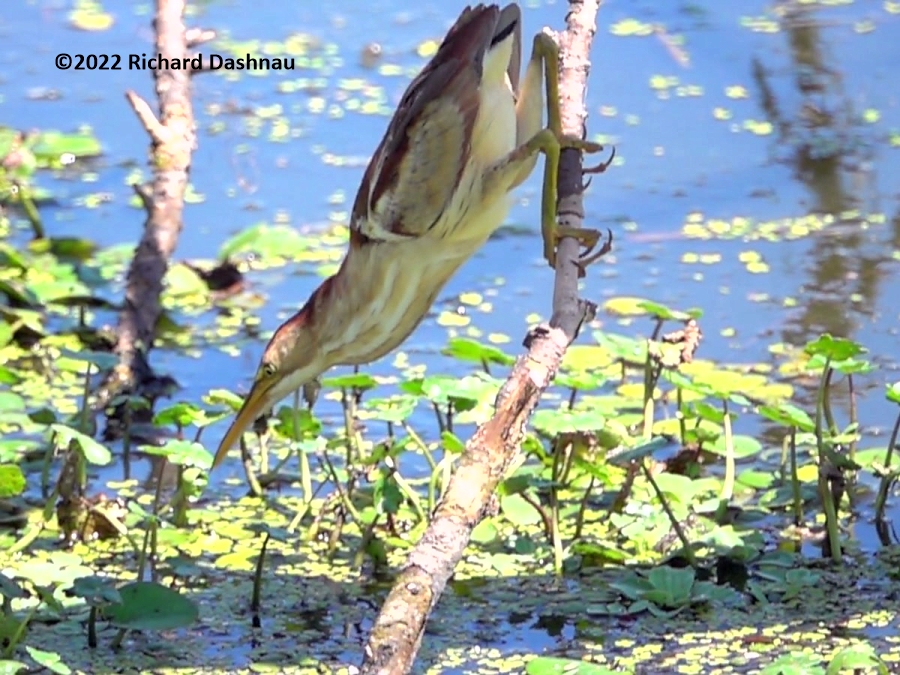
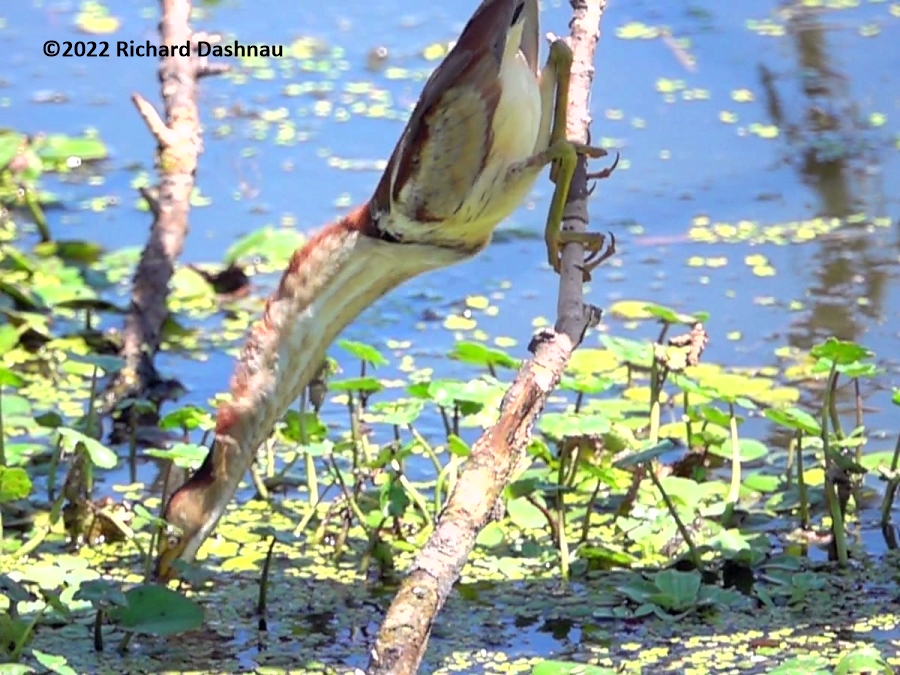
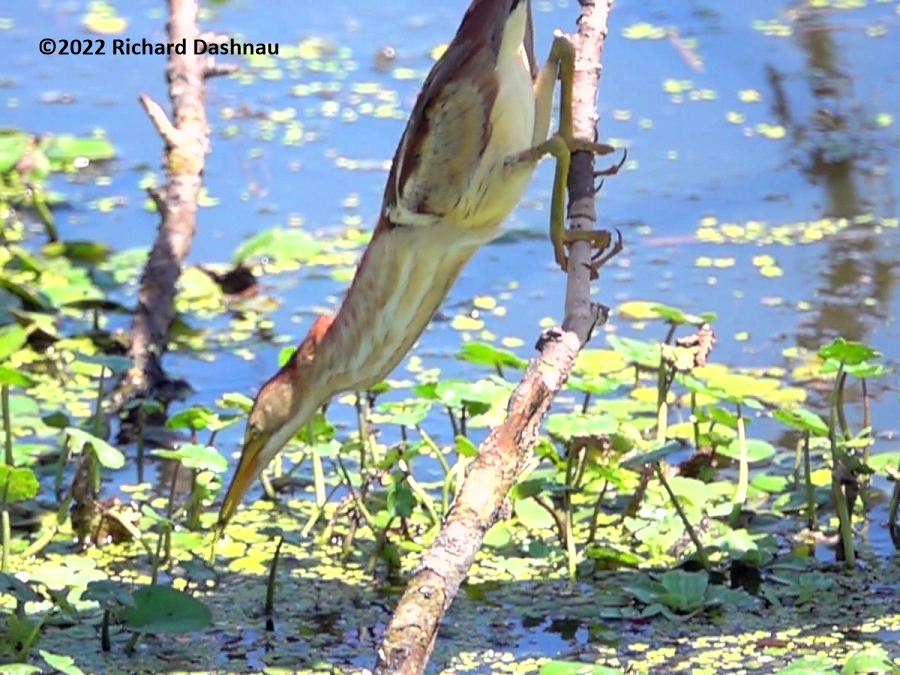
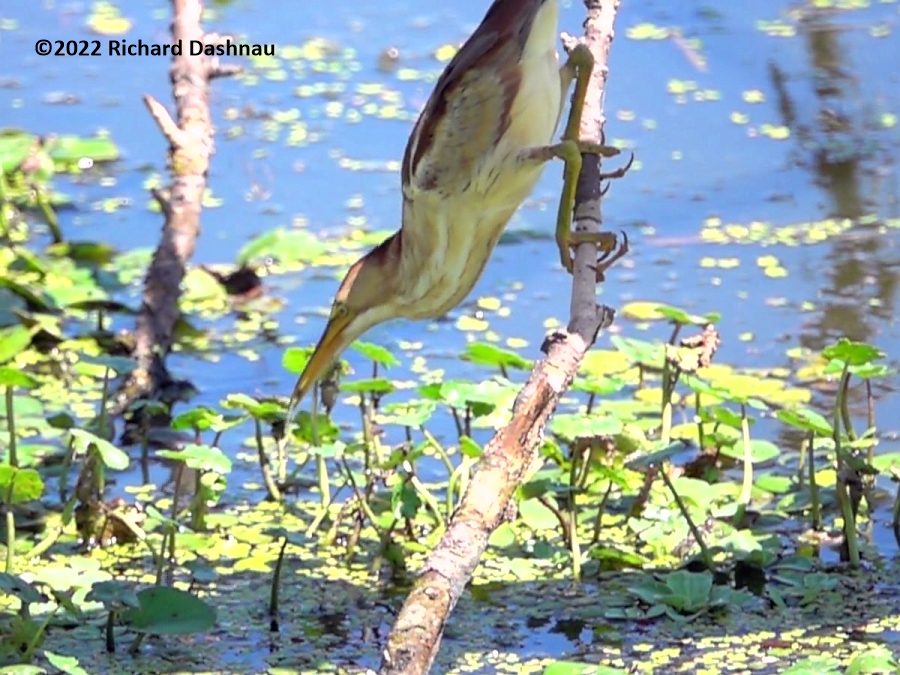
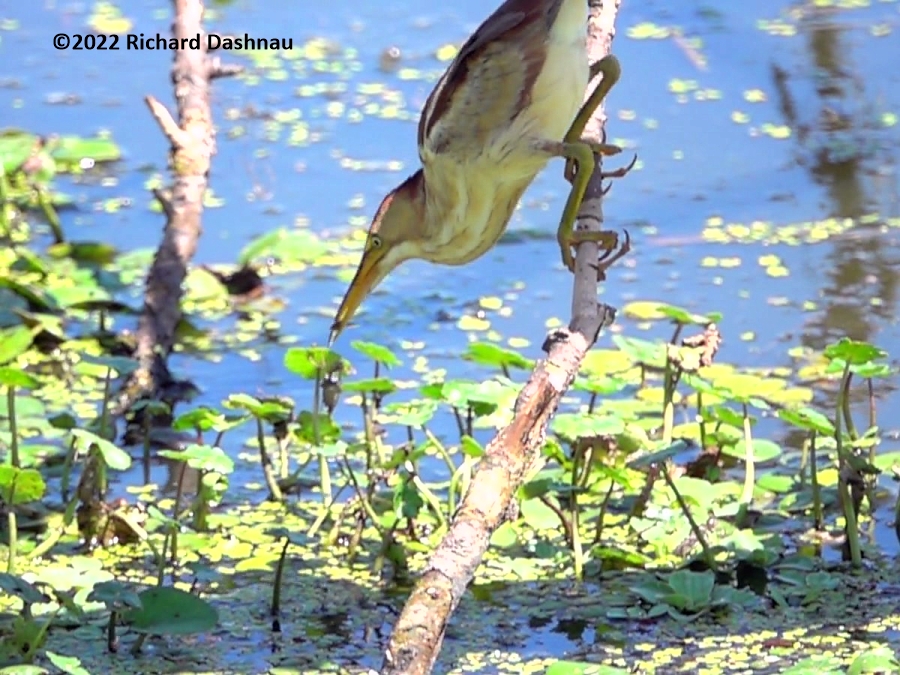
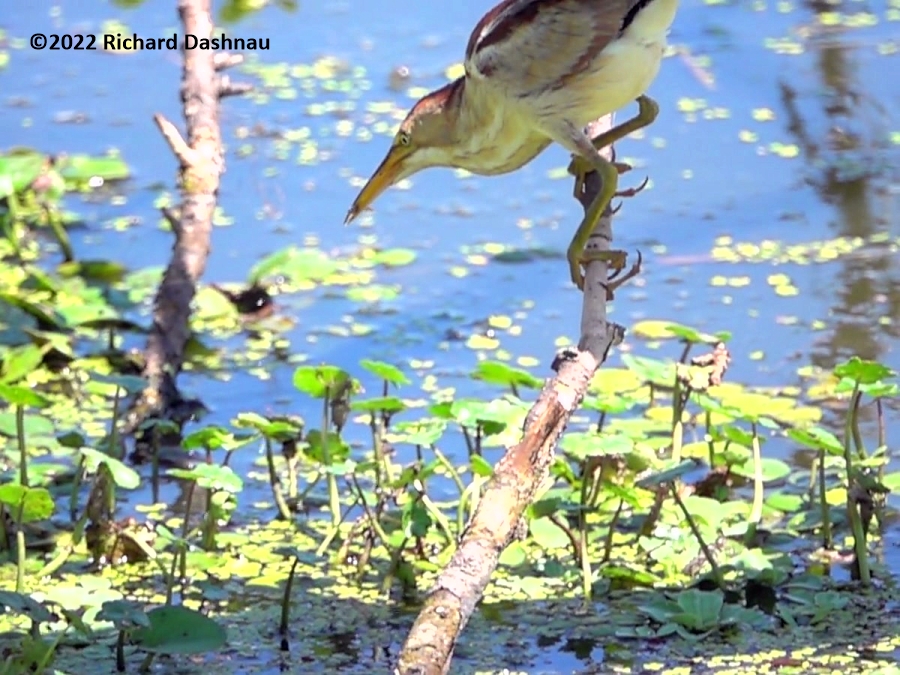
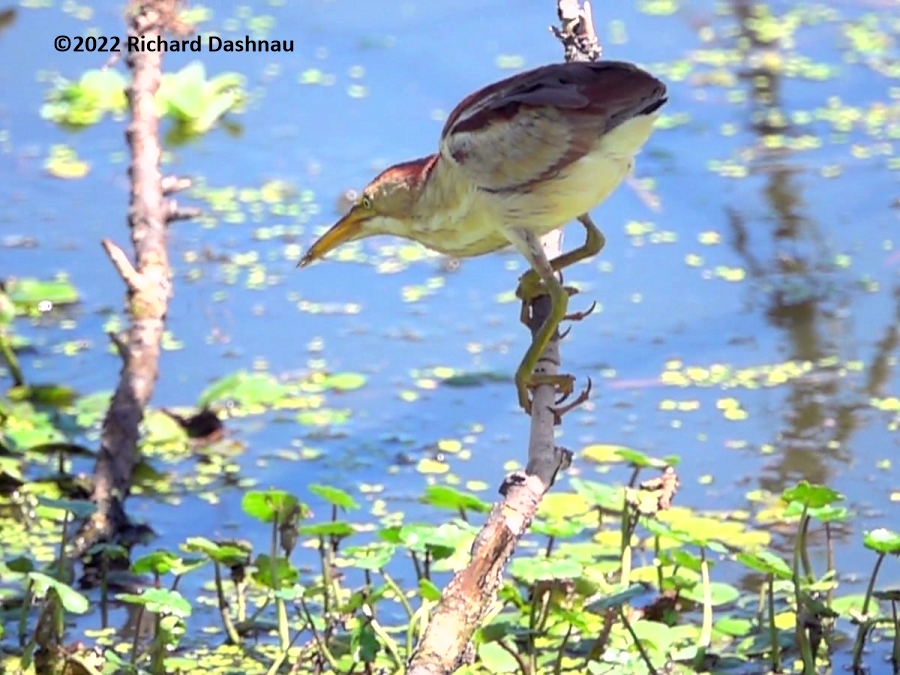
Update 06/09/2022 - From BBSP on 06/05/2022
Due to trail construction, lack of rain, and the heat, the water level
in Pilant Lake has dropped dramatically over the last month or so.
The
first picture, taken near the Observation Tower, shows how far the
water has lowered, and the small channel made by drainage. While
the high number of Green Herons was unusual
(well, for me, at least) I
was really surprised when I saw at least 4 Least Bitterns! They are
usually shy, and I don't see them often. But four of them were
hunting near the Spillway Bridge,
along with the Green Herons.
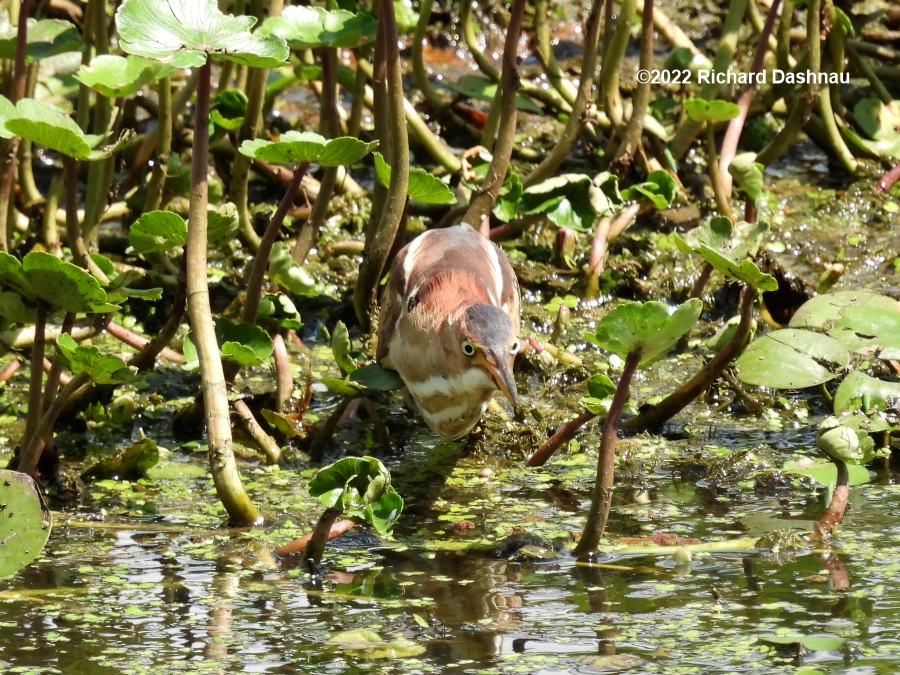
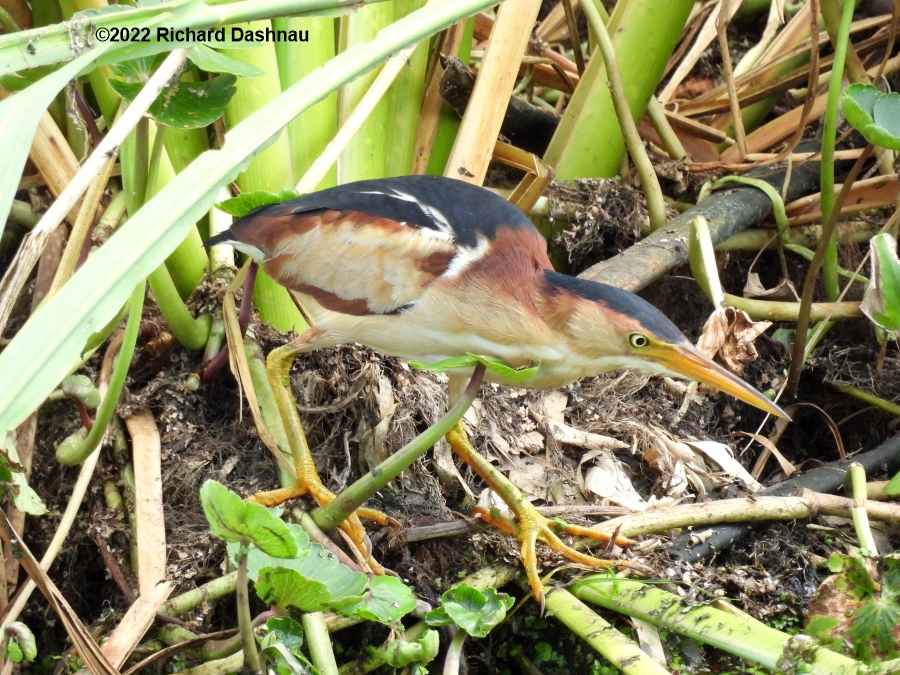
03/07/2021
What
did I see today? Well, here we go. I
passed at least 6 American Bitterns (Botaurus lentiginosus) in the
morning. I caught photos as one of them successfully caught
crawfish,
but the lighting was bad. I always enjoy seeing Bitterns!
The
first two images below are shots taken of different Bitterns as they
foraged. The third image is a frame from a
video (mp4) showing the Bittern
doing a swaying motion. In this article:
"Kushlan, J. A. 2011.
The terminology of courtship, nesting, feeding and maintenance in
herons.", it says this: "While Neck Swaying, the neck and sometimes the
body is moved from side
to side, the head tending to be rather
stationary. Neck Swaying while feeding may be a method of
enticing small movements of prey, while the heron’s head remains ready
to strike. Neck
Swaying is also used in the Bittern Posture,
probably to increase camouflage value." Since the head
doesn't
move while the neck and body does, it doesn't make sense that this
movement
is to allow perceptive focus for targeting prey. I'd
always considered it as a feint that might distract attention from the
stationary head just before a strike. I hadn't considered
that
the
movement could also serve to startle prey into movement.
There are other head movements that do
allow for focusing (from same article: "Head Swaying and Head Bobbing
are probably
used to obtain
parallax and gain a more accurate estimate of a prey item's location
and distance.") Finally, here's an alligator helping give
extra
emphasis to one of our alligator warning signs.
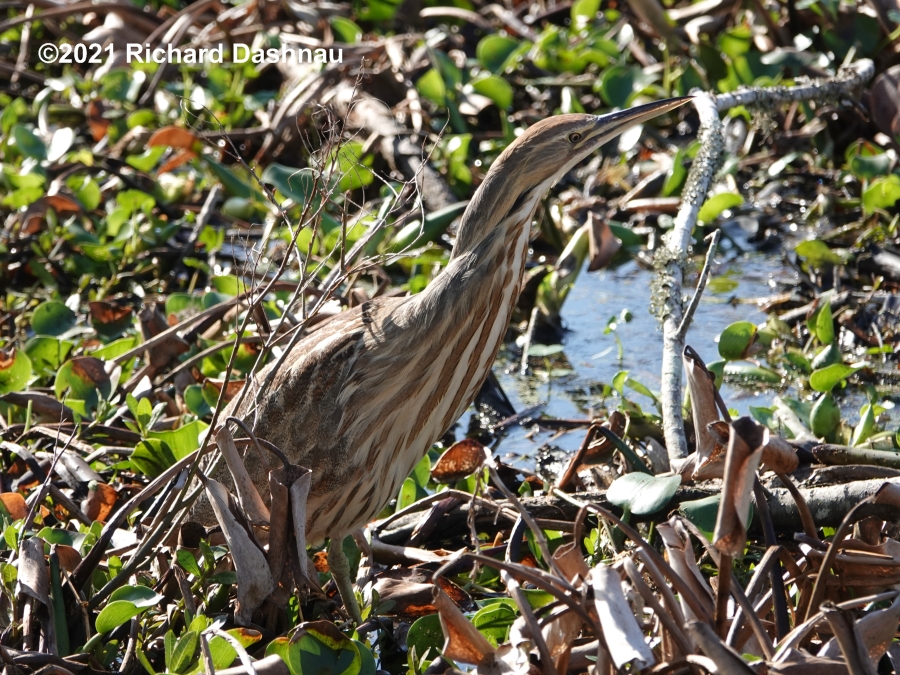
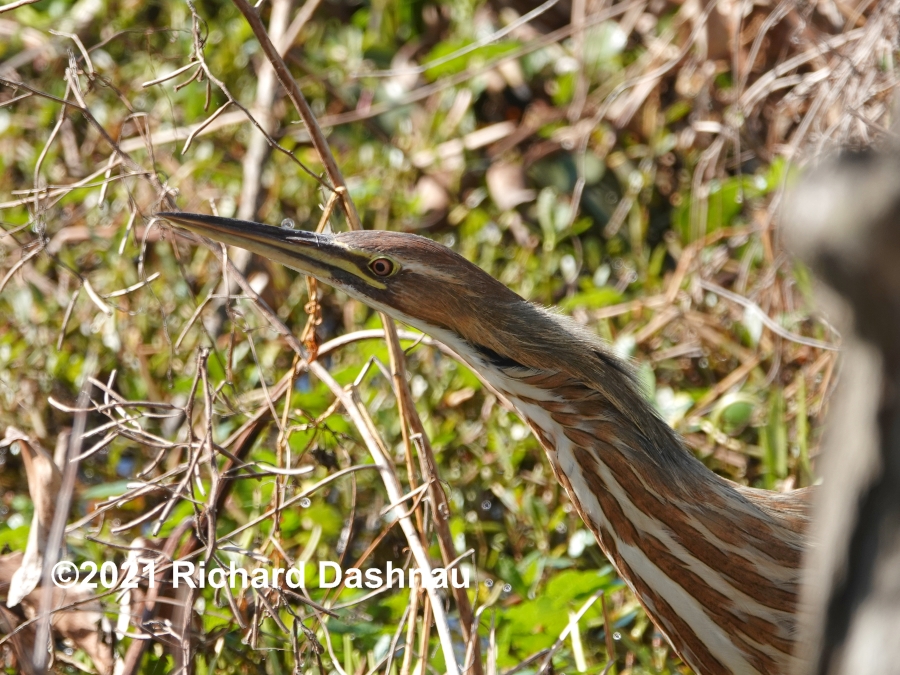
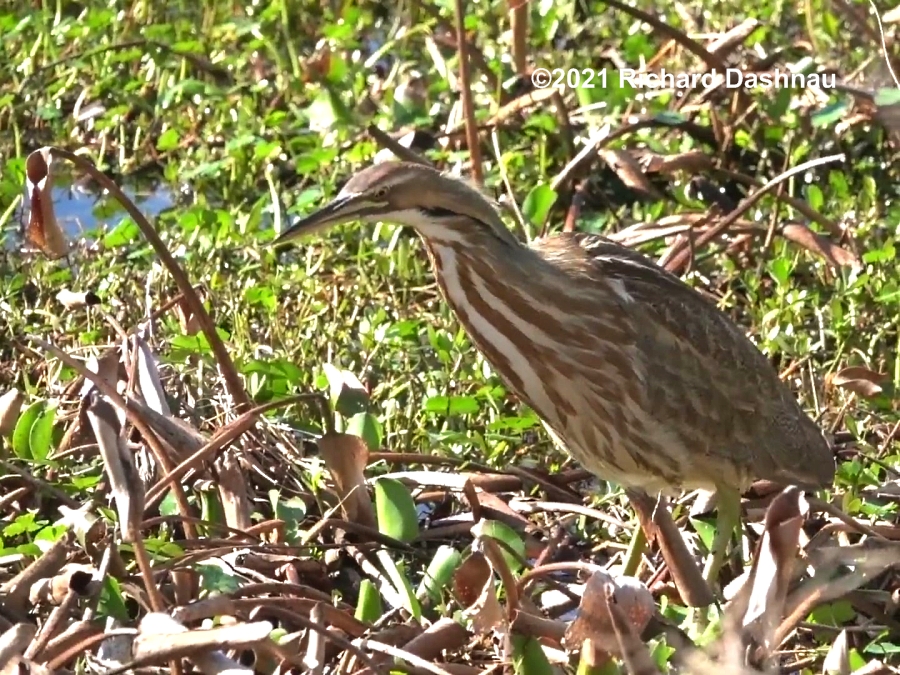
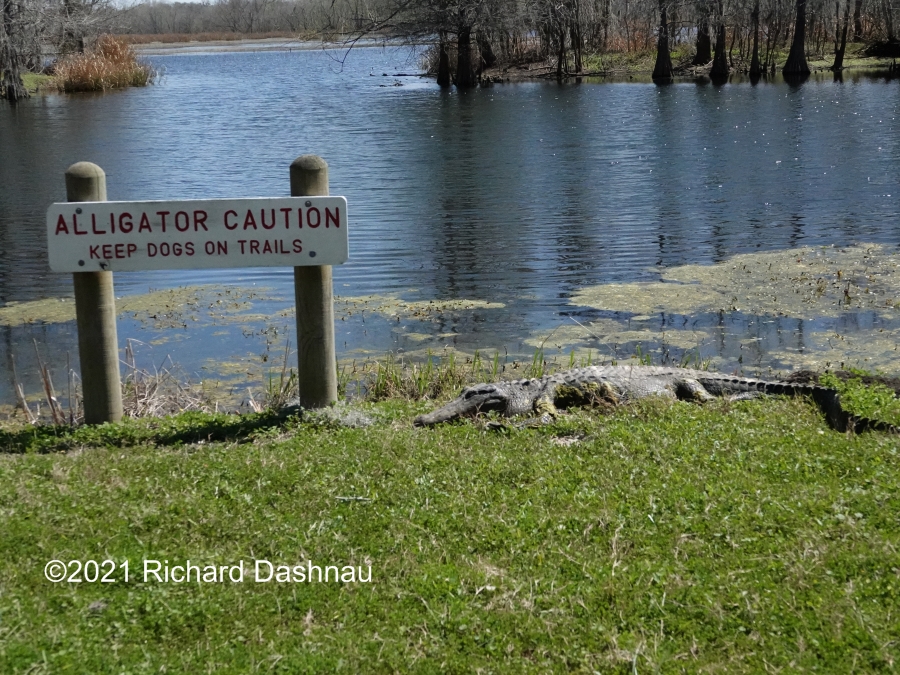
Bittern just looking
around.
I really like this one,
peaking around a tree..
Looking forward, neck swaying..
Just
pay attention to the sign, okay?
04/28/2019
I was near the 40 Acre Lake Observation Tower when I noticed a small,
brownish bird landing on the floating vegetation. A closer
look
through the binoculars revealed that it was
a
Least Bittern (Ixobrychus exilis). While they do live in
Brazos
Bend State Park, sightings are relatively rare, since Least Bitterns
are usually shy. Although they resemble the more commonly-
seen American
Bittern (Botaurus lentiginosus), they are less than half the length (11
inches for Least; 26 inches for American); and they are colored
differently. With the Least having a "dark
crown and back, with buff-colored
wing patches" while the American has a "dark moustachial streak,
developed into a black triangular patch on either side of the
head...and by it's finely
spotted
and vermiculated upper parts." (these decriptions are from
The
Herons Handbook by James Hancock and James Kushlan 1984 pages 236 and
268)
The
bittern was about 50 yards from me, so I was able to watch it through
the binoculars, and then through the camera for a few minutes.
It
foraged a while, and then flew off into cover.
The two images below
were the best I could crop from the long-distance photos.
And, the short video clip showing the bittern
hunting is here(mp4). It was a rare treat to see
the bittern at all,
so I'm sharing the video here.
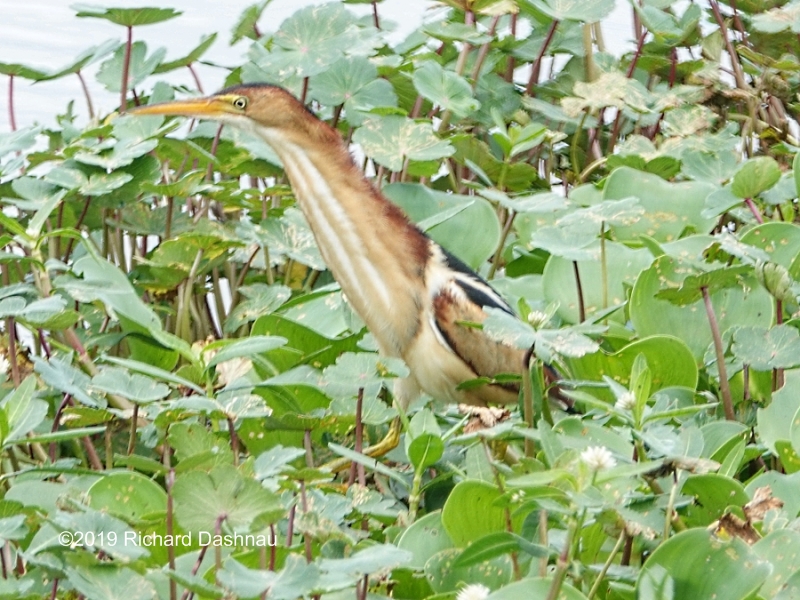
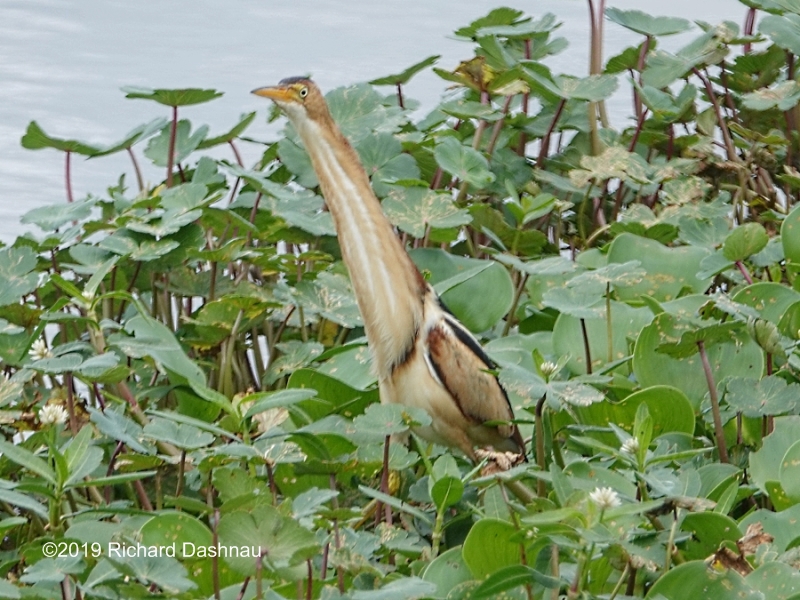
01/01/2019
I was hurrying back to the 40 Acre Lake parking lot to meet for a hike,
when I noticed this American Bittern (Botaurus lentiginosus)
capture
something. I stopped walking and shot video for a few minutes. The
Bittern had caught a Lesser Siren (Siren intermedia), and had quite a
struggle
with
it. The image below is an image from this
video clip(mp4), the video
was shot at 60 fps but I've slowed it to 15fps for clarity of movement.
After witnessing
the
end of the struggle, I really had to hurry to meet up with the hike.
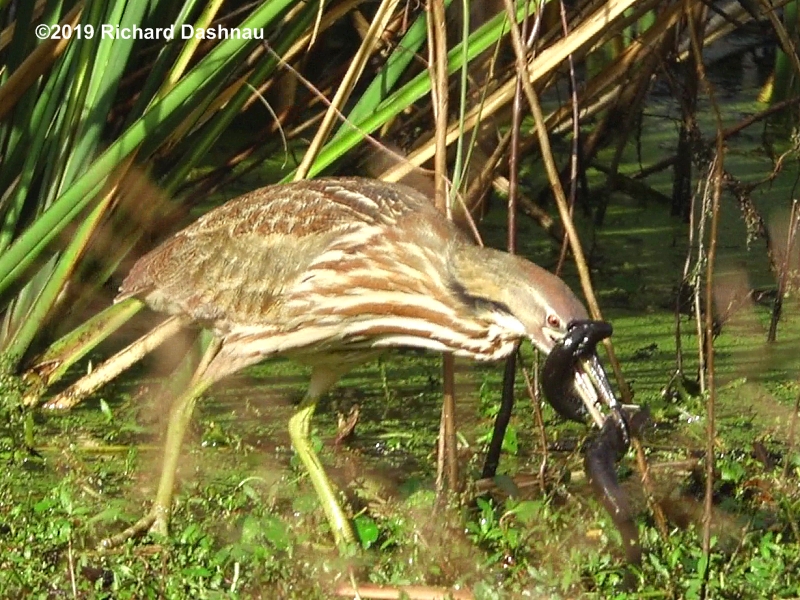
March 22, 2015--(uploaded
3/12/2024) I
watched a Bittern calling and captured detailed video of multiple
callls at normal frame rate and at 120 fps. Although the video was
interesting,
I hadn't done anything with it until now (2024...9
years later, Wow!). The Bittern calling video will
be here
(mp4). The images below are from photographs of the Bittern. I've found
two sources
that gave me some very interesting concepts related to Bitterns and
other birds:
#1.
" The Function of the Oesophagus in the Bittern's Booming" James P.
Chapin (1922) and #2. "Coos, booms, and hoots: The evolution of
closed-mouth vocal behavior in birds" by
Tobias Riede, Chad M. Eliason, Edward H. Miller, Franz Goller, and
Julia A. Clarke (2016)
(Chapin 1922)
described "two curious elongated pads" on the inner surface of the
joint of the lower mandible (mandibular rami); and guesses that they
may serve as a plug to
keep air in the gullet. They seem to be
temporary structures. Just closing a bird's beak alone wouldn't work to
keep air in the oesophagus, so the extra pads would be needed.
The
conclusion is that the Bittern does inflate its oesphagus, but the
process for doing that is unknown. I made the third image below from
digital models of a Eurasian Bittern
(Botaurus stellaris) skull and mandible that I placed together, then
took a screenshot--which I drew on.
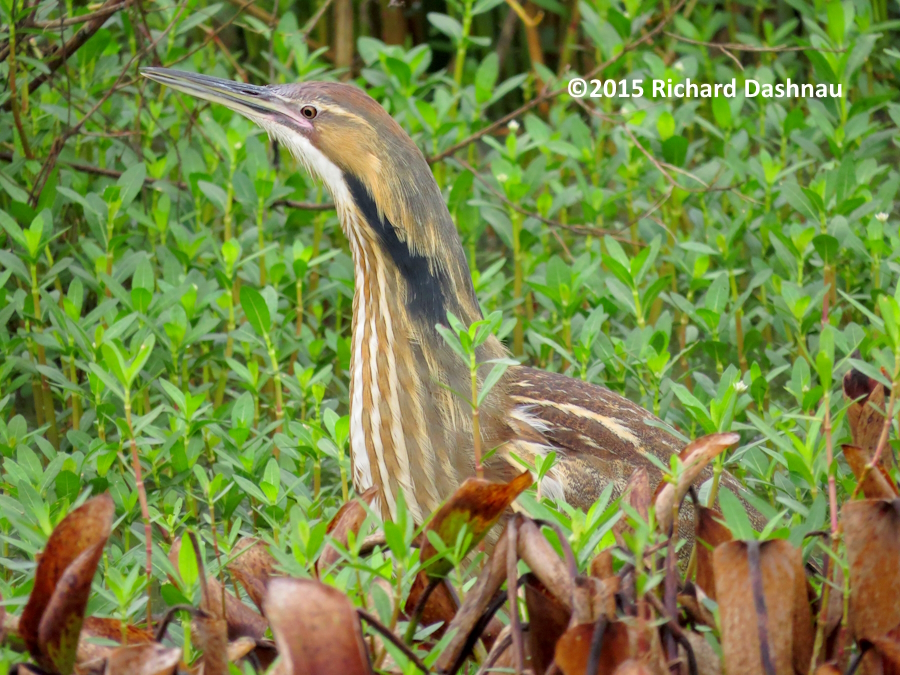
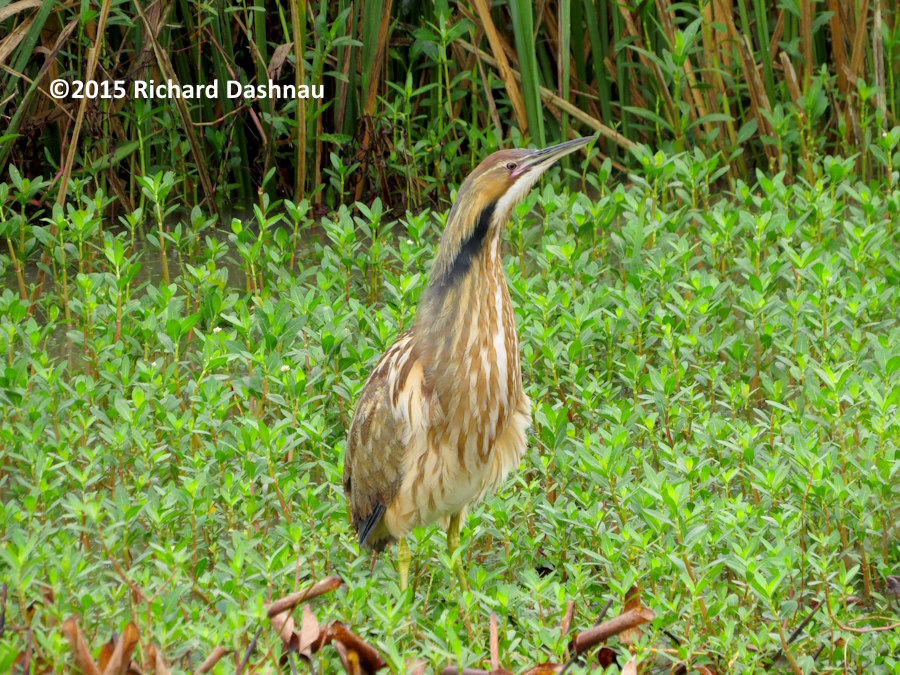

The
batch of images below are frame grabs showing a Bittern
calling
event. They often start by slapping the beak closed, making a
distinct "clack" sound. This might be
amplified by the
expanded throat--expanded by air in the esophagus. As seen in
slow-motion, the first beak slaps might include gulps of air being
captured into the esophagus.
This is all shown in the video that I edited from captured
footage of different calls that day.
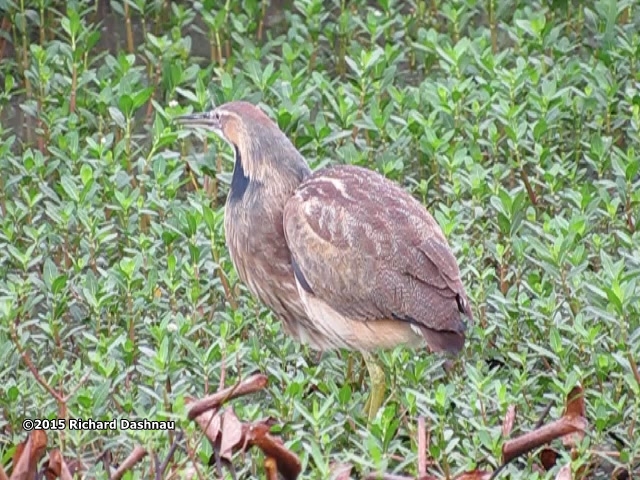
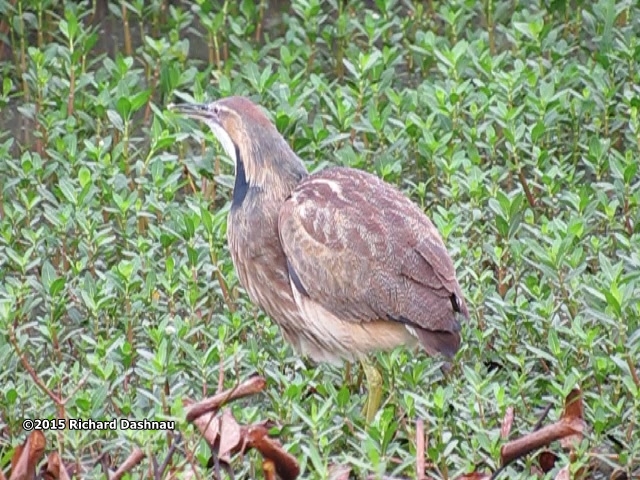
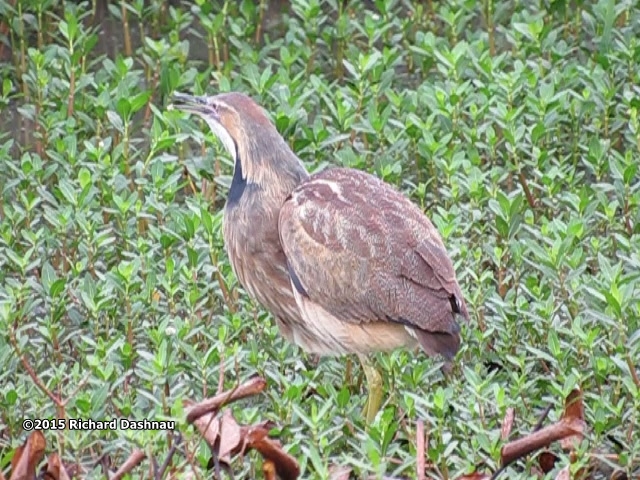
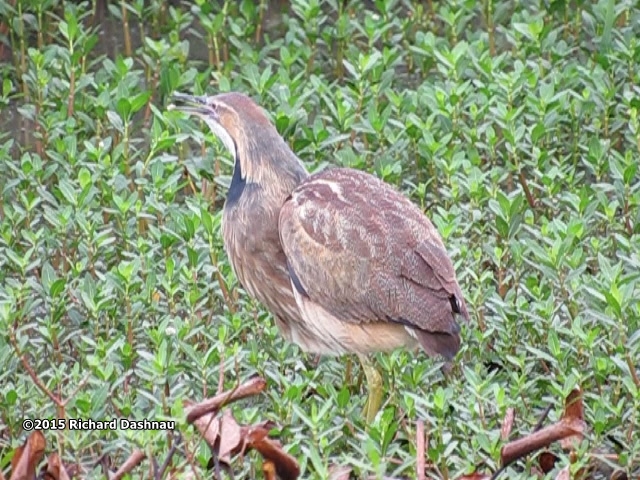
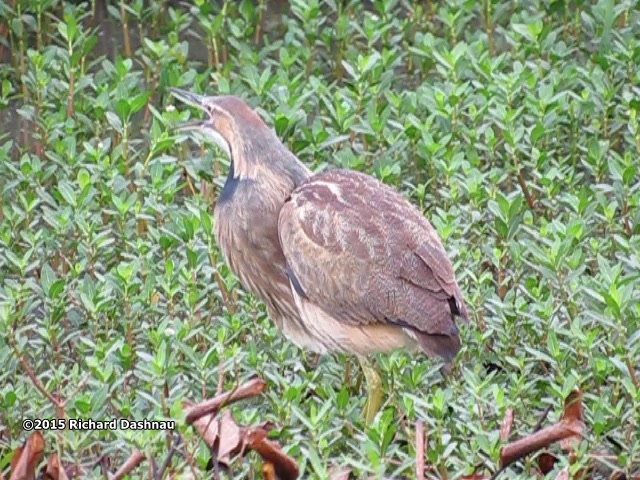
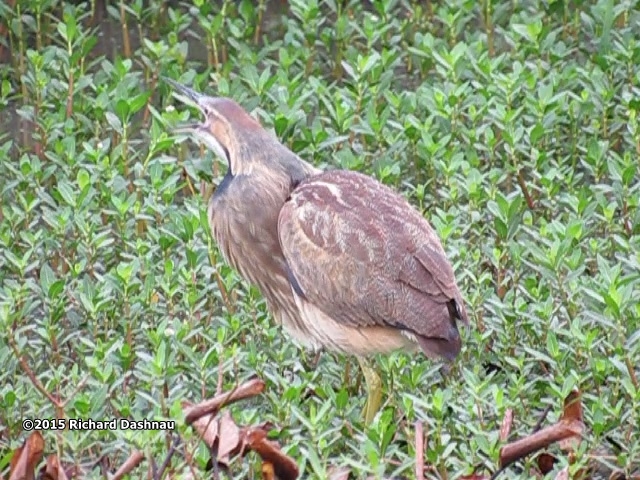
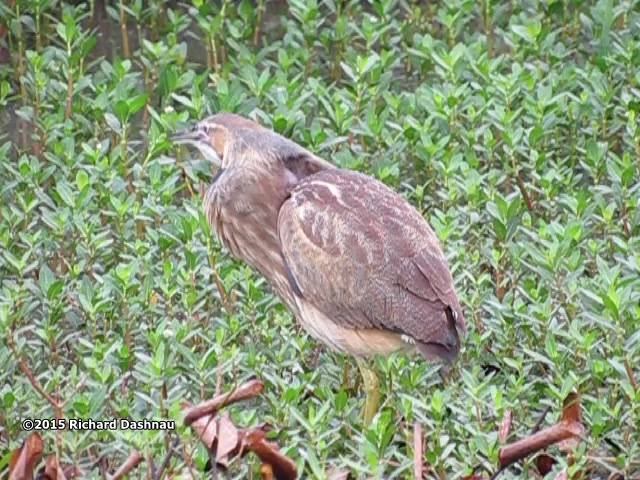
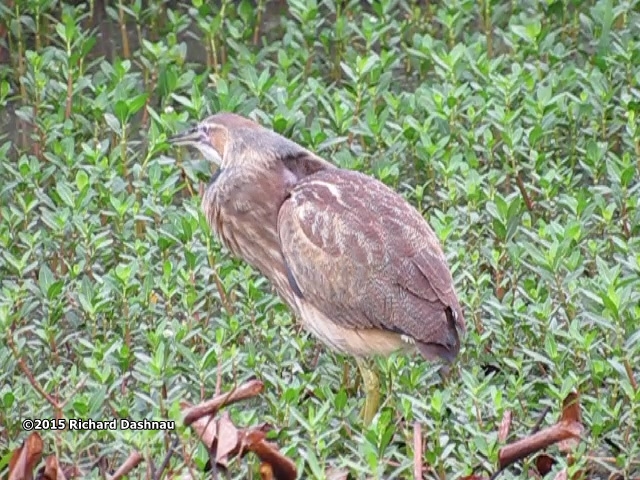
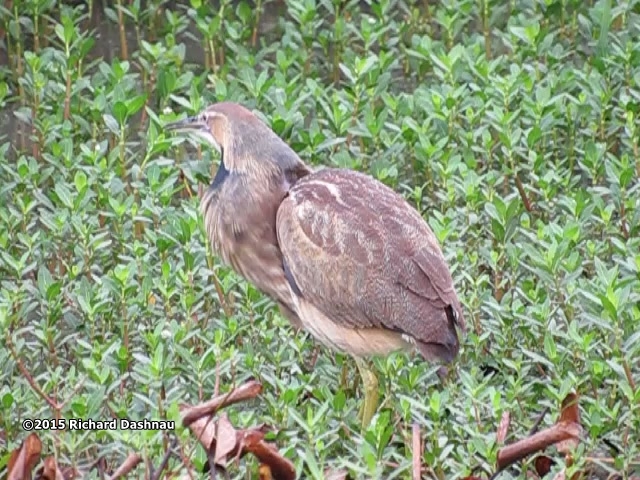
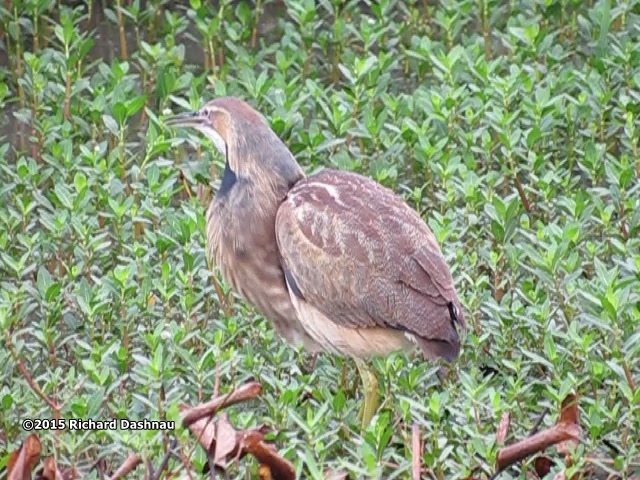
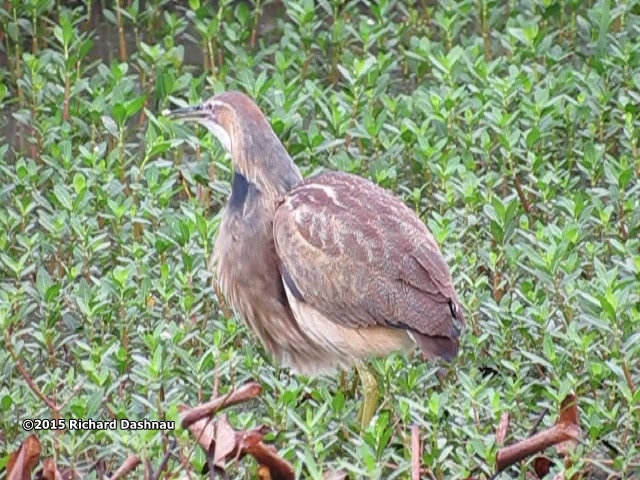
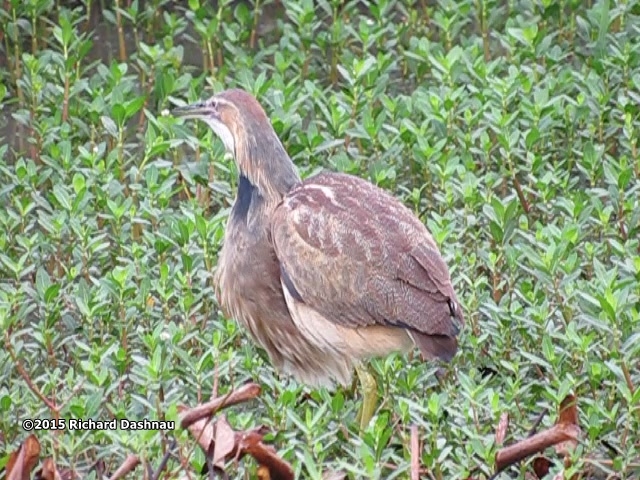
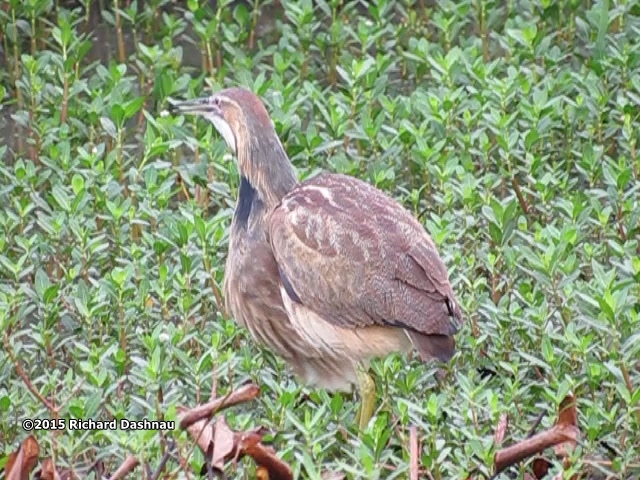
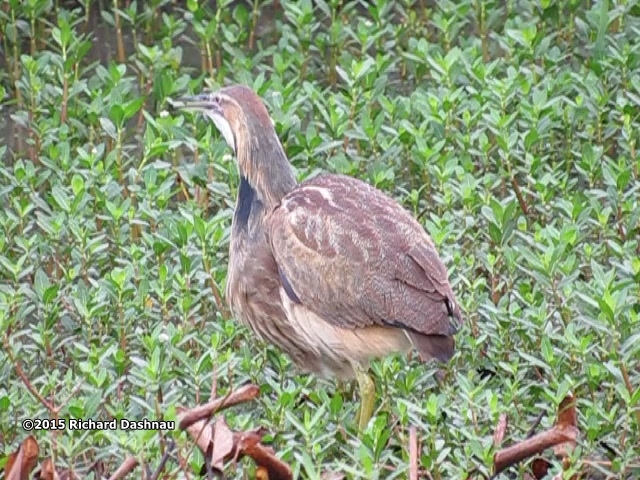
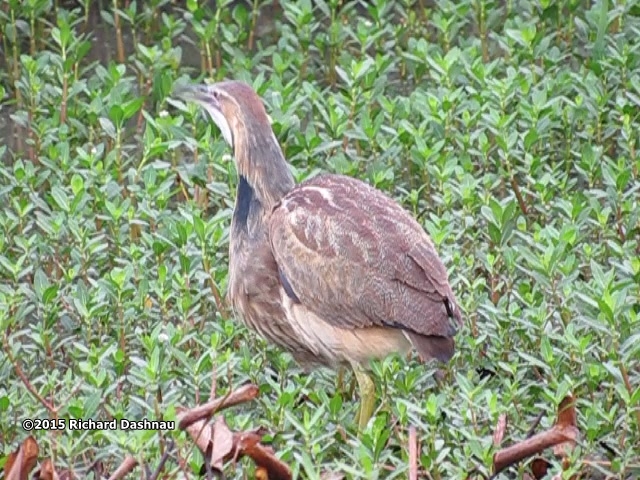
The
actual "call" follows, with more pronounced head thrust and the
"goo-gunk" sound, and much larger bladder expansion. Along
with
the sounds-and not visible from this angle
are the flashes of color by expanding the feathers along the neck and
throat.
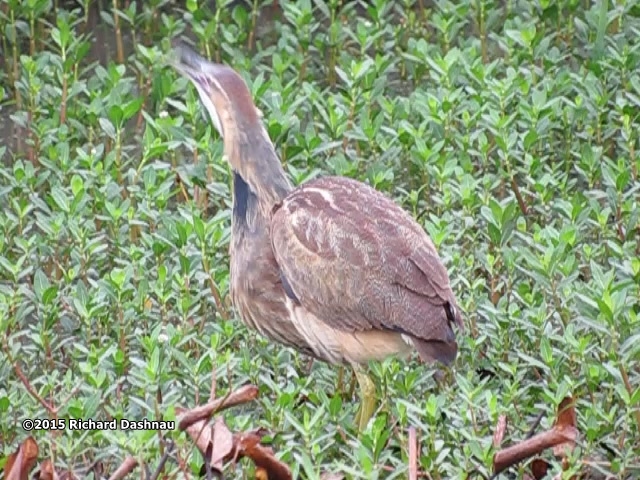
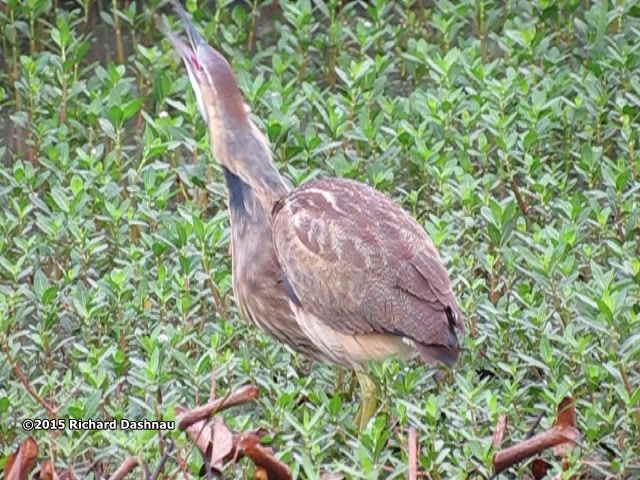
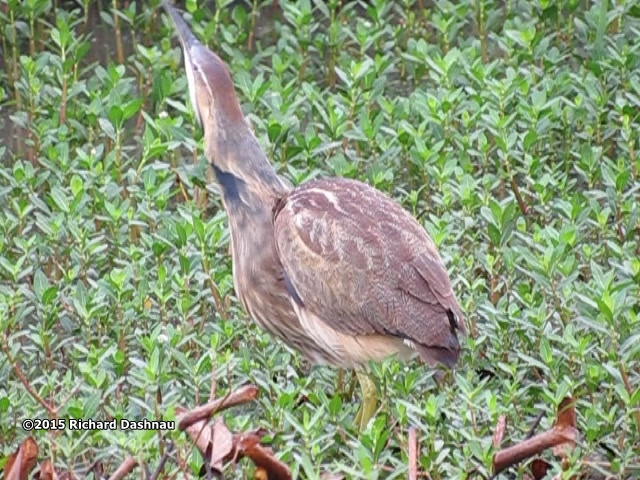
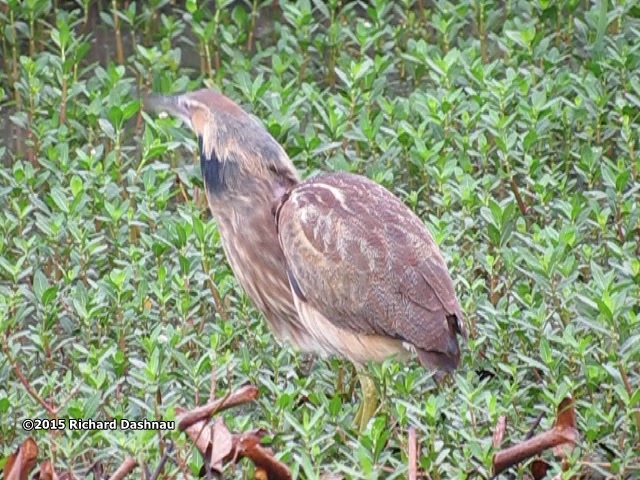
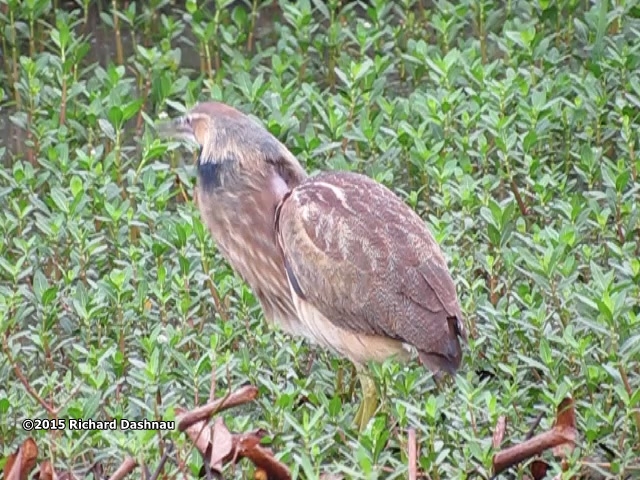
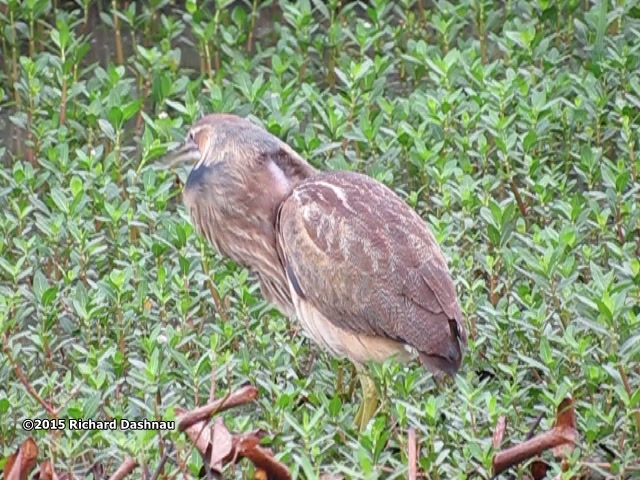
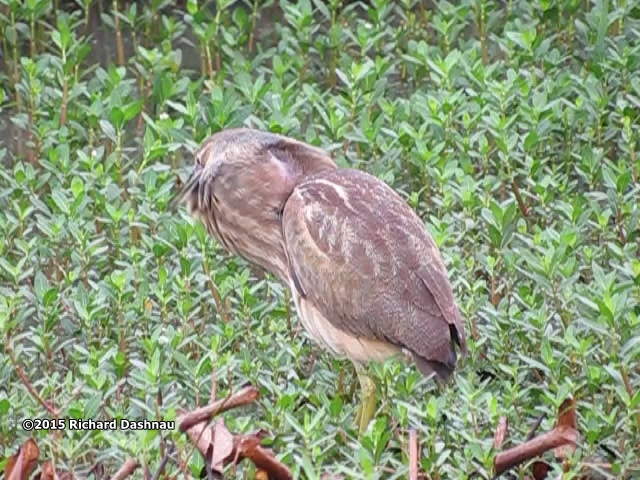
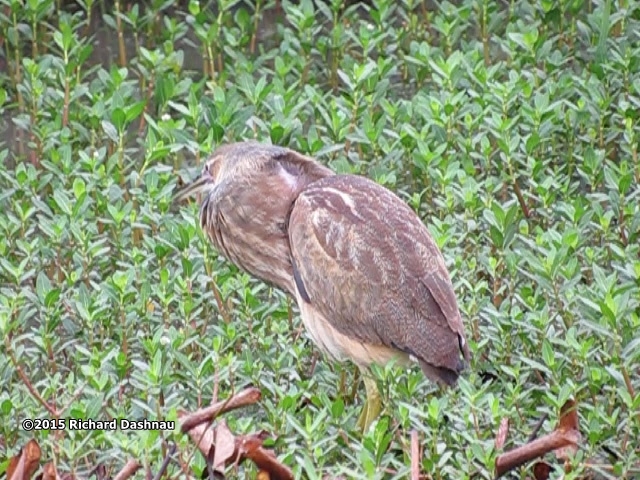
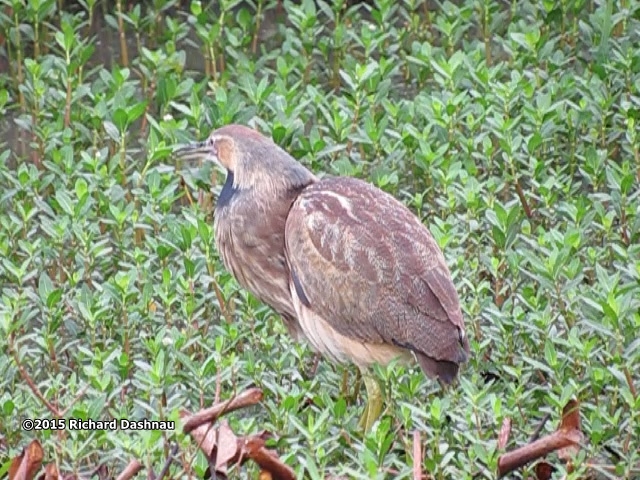
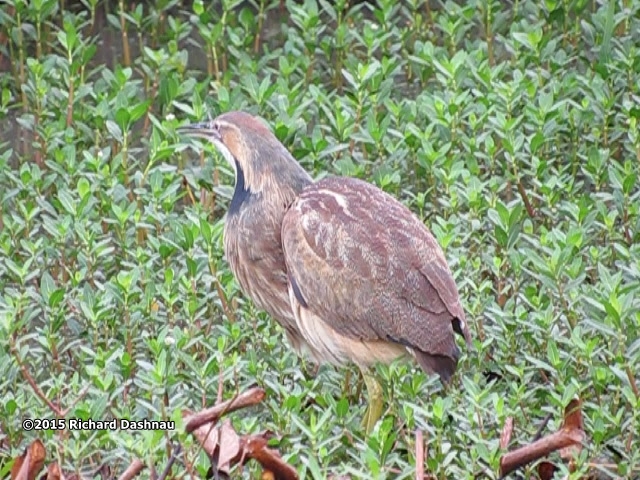
February 1,8,15, 2015--Three
weekends of Bitternness....
Between the good rains we had from last year, and some from this year,
water levels in the park have been the highest in
years. This has
evidently been good for the American Bitterns, and they have been
active! This is what I was able to see over the last few weeks:
February
1st, I watched a Bittern hunting. I noticed it because of the position
of its neck and head. The Bittern's neck was fully extended, and it was
focused on something in the plants. (PIC 01)
Then, it slowly moved
forward, keeping its head still, but "taking up the slack" of its neck.
And when it launched its head forward, it was rewarded with a crawfish.
The two pictures show the the
neck fully-extended, and then the
crawfish in its beak.(PIC 02) This video clip shows the actual capture
and then the removal of one of the crawfish's claws.
The
Bittern continued hunting, when another Bittern walked out of the rice,
within view of the first Bittern. This newcomer started walking quickly
towards the first Bittern. I began filming at
high-speed, because I
expected to see conflict, and I wanted to define how that unfolded.
Instead, the Bitterns began a display behavior that I had never seen
before. Both of them "bowed"
bending forward, and then they opened
their wings and exposed white patches on their backs. At that
point, they began walking slowly-in a "stalking" manner, showing their
backs to each other.
After a few minutes of this circling, they moved
away from each other. They made no sound. This interaction amazed me,
and I tried to catch everything I could with my camera--but I didn't
want
to risk changing any settings or risk looking away. The Bitterns
were only about 10 yards away and I didn't want them to notice me.
Still, I thought the footage and images I caught were amazing.
Photos
and framegrabs from the video are PIC 03, PIC 04, PIC 05.
The Bittern catching the crawfish video is here
(mp4) . The Bittern conflict
video is here
(mp4) .
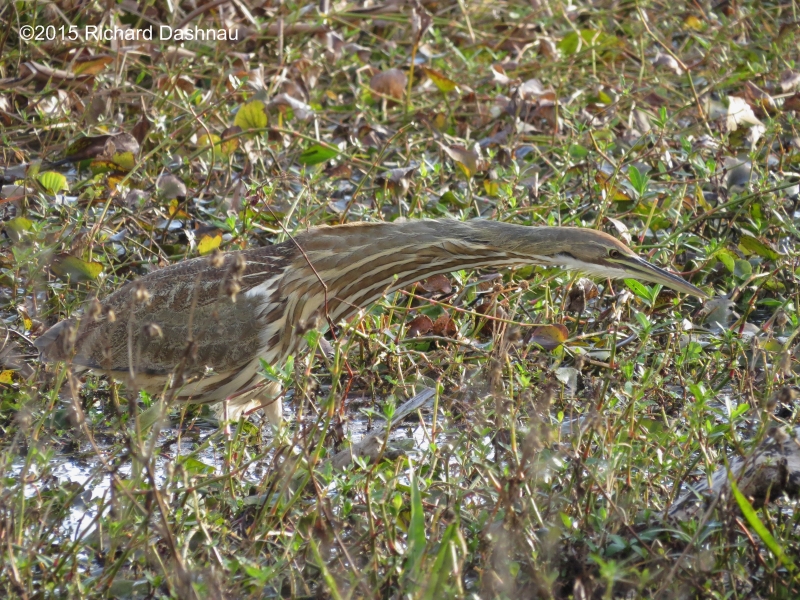
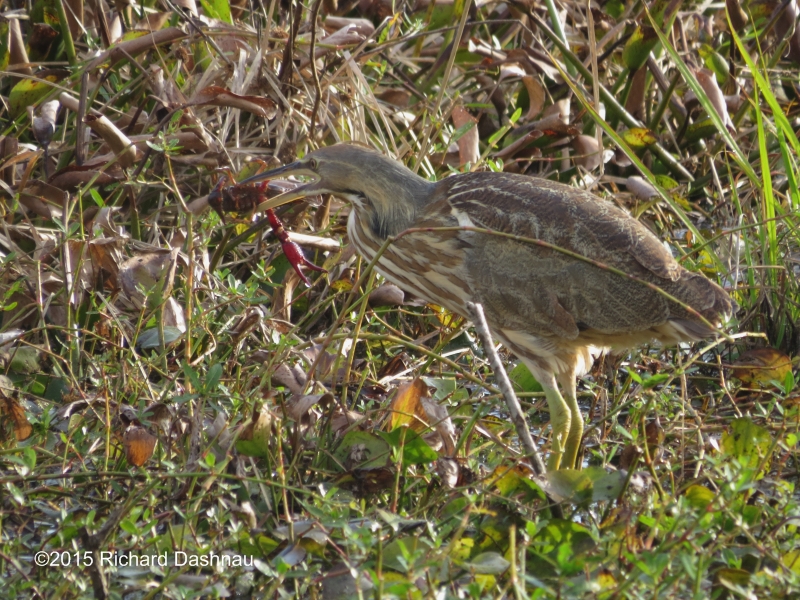
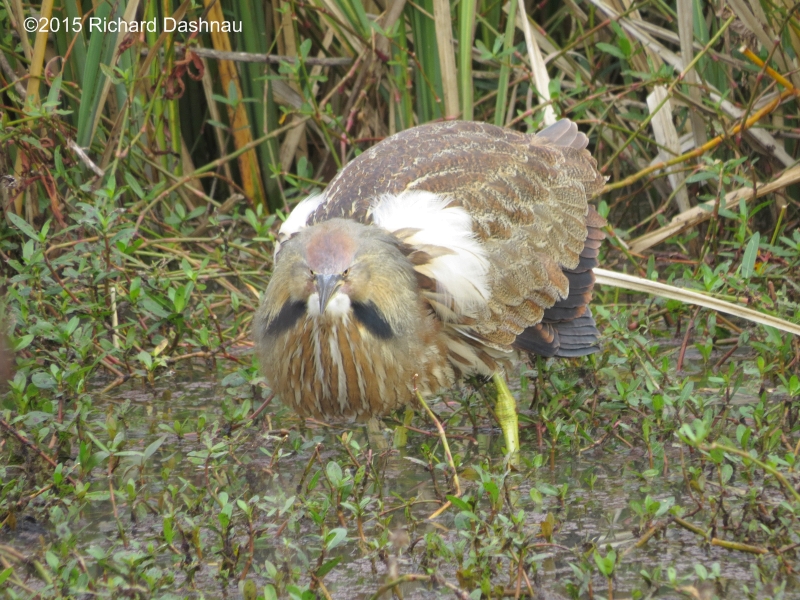
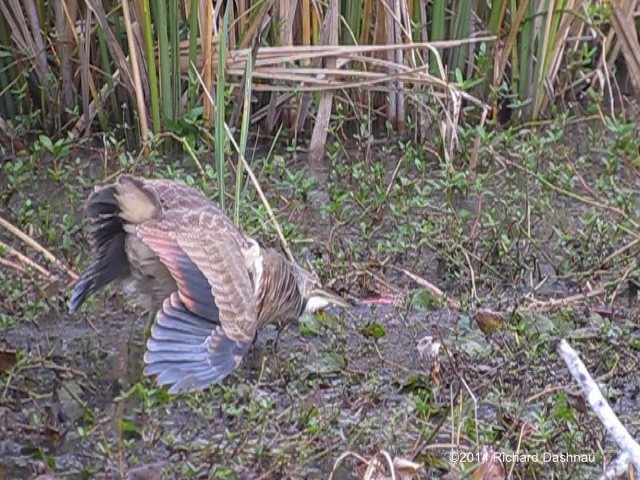
PIC 01
PIC 02
PIC 03
PIC 04
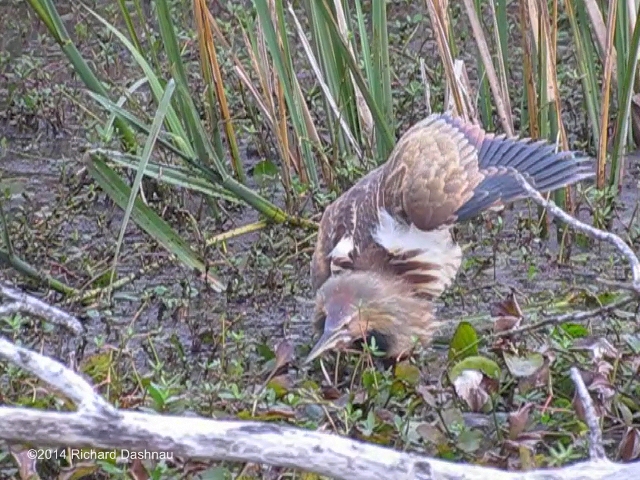
PIC 05
On
February 8th, I was at the same part of the 40 Acre Lake trail. There,
I watched a Bittern as it hunted. After a while, it went to a small
"nook" in the wild rice, faced the rice, and began
swaying. I thought
this this might meanthat it would begin "booming", and it appeared to
start to call, but I couldn't be sure because of the wind blowing.
Just a few minutes later, another
Bittern flew out of the rice,
and landed a few yards from where the first Bitternwas
standing.
It appeared to start into the rice, and I began filming. And, I was
treated to ANOTHER
territorial display. This confrontation lasted for
about 5 minutes, and finally ended with the first Bittern having moved
off, and the "newcomer" standing in the same spot where the
first
Bittern had
been standing, and almost in the same position! After a few
minutes, the "newcomer" turned, and began hunting. After about 10
minutes, it caught a crawfish. When it began
to eat it, the "first"
Bittern came rushing back, from some yards away, in a major aggressive
display. After more confrontation, the Bitterns seem to arrive at a
sort of truce, and they passed
each other, though keeping their
distance, and continued hunting. I filmed most of this. I
extracted some
frames from these clips video, and images below are some of those
frame-grabs.
In 2021 I've put the video clips of from
this together into one large file.
I
have never seen any behavior like this between Bitterns. I have found a
few references to it. In my copy of The Herons Handbook by
John
Hancock and James Kushlan there is reference
(on page 271) to a
description of behavior in 1911. This description can be found
online
(look for "Concerning
the Nuptial Plumes Worn by Certain Bitterns and the Manner in Which
They Are Displayed" by William Brewster). I
also found some interesting
descriptions here:
https://johncpitcherart.wordpress.com/2014/04/26/american-bittern-behavior-sketches/
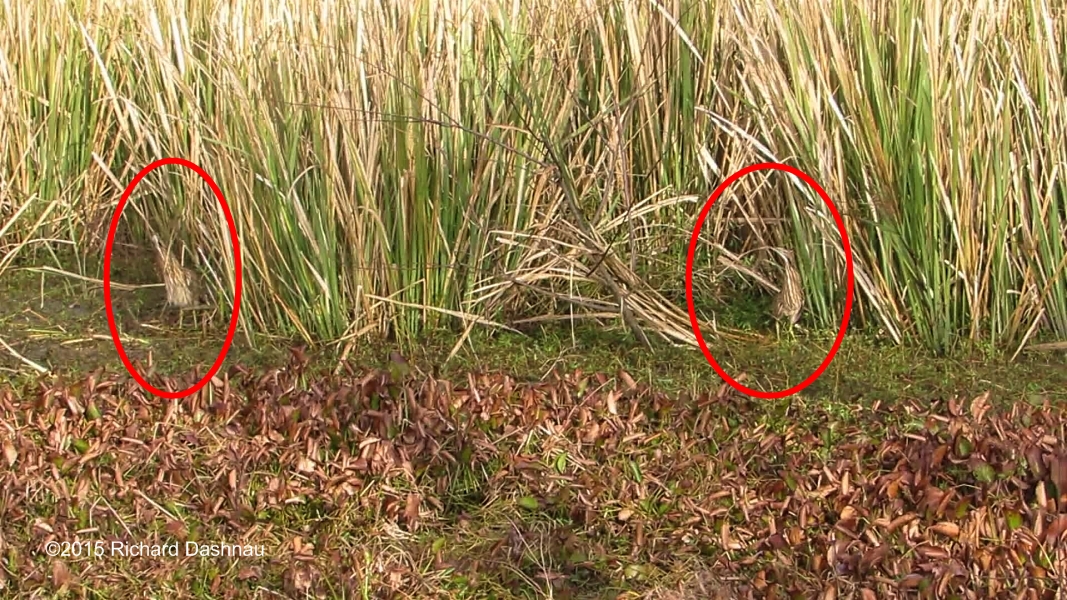
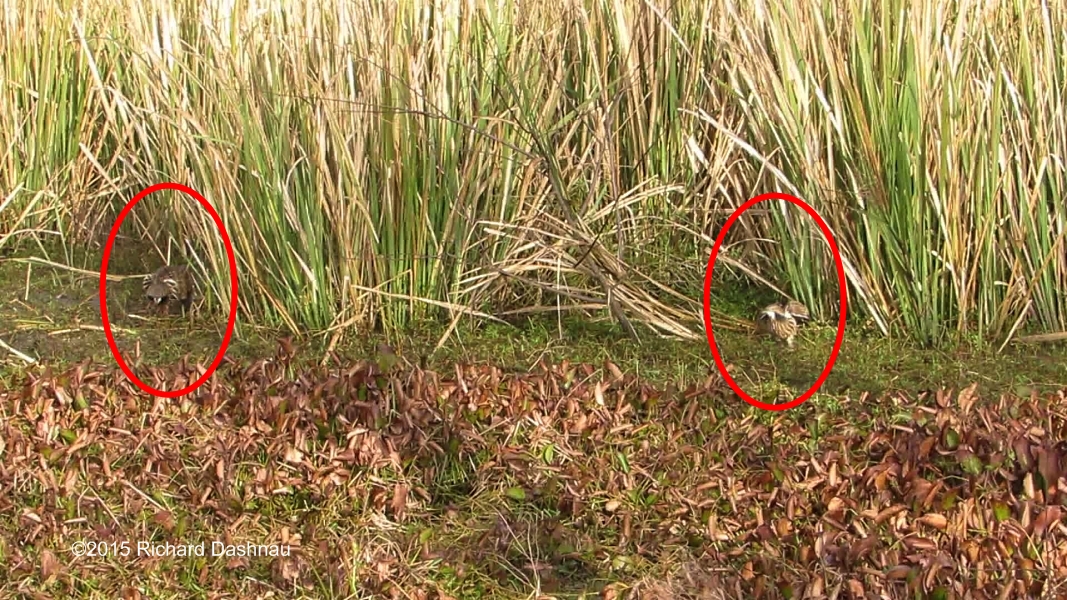
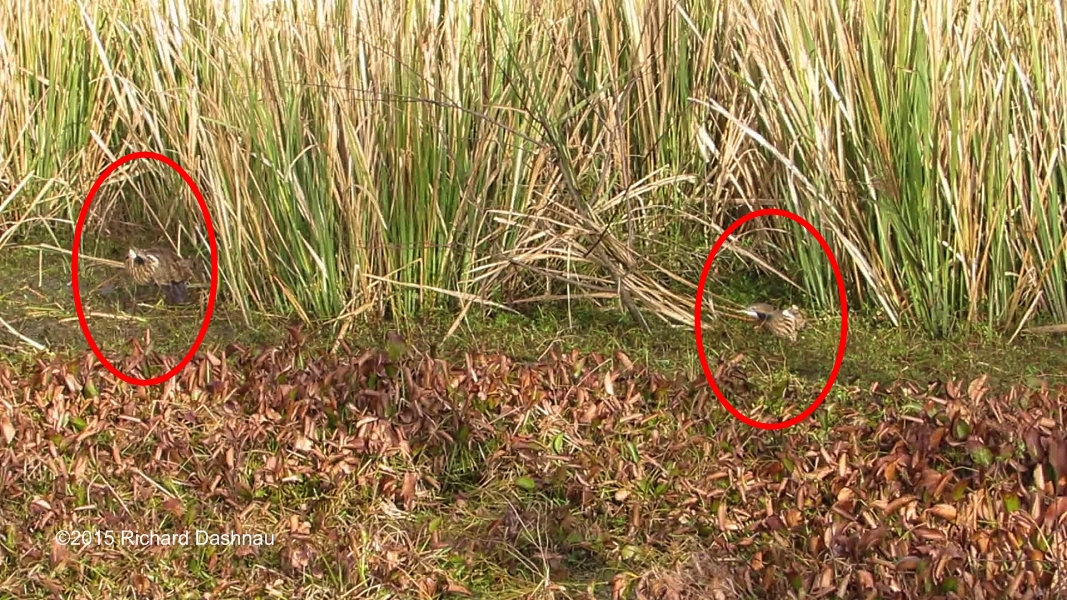
PIC 06
PIC 07
PIC 08
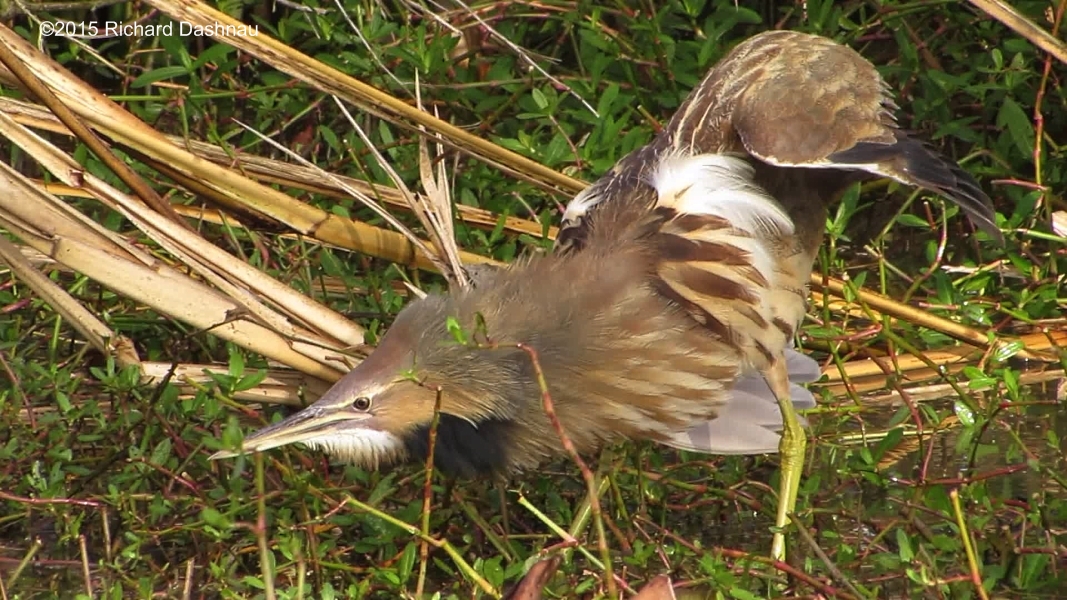
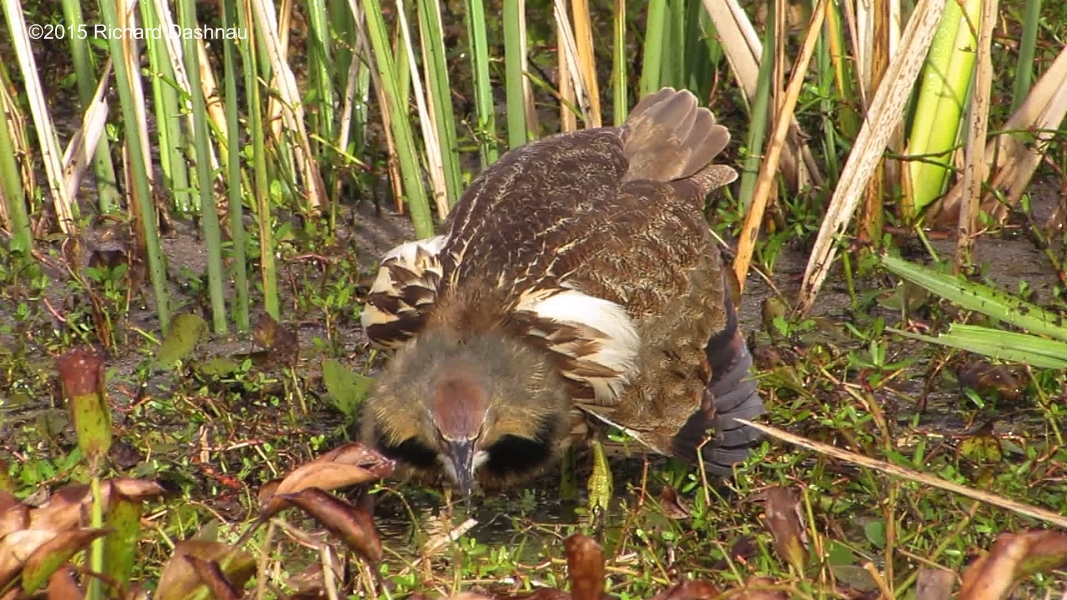
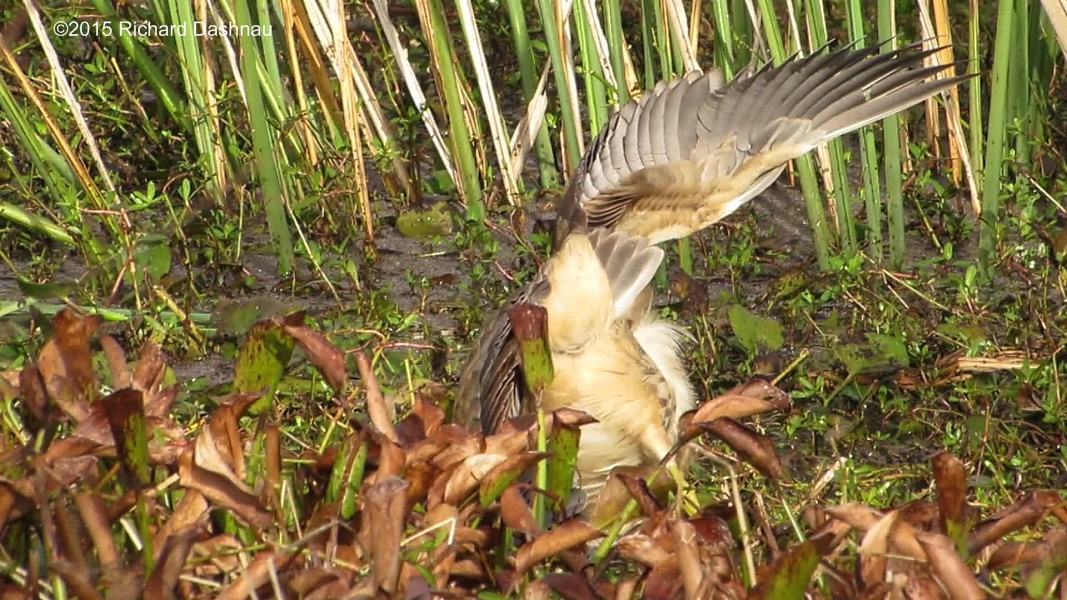
PIC 09
PIC 10
PIC 11
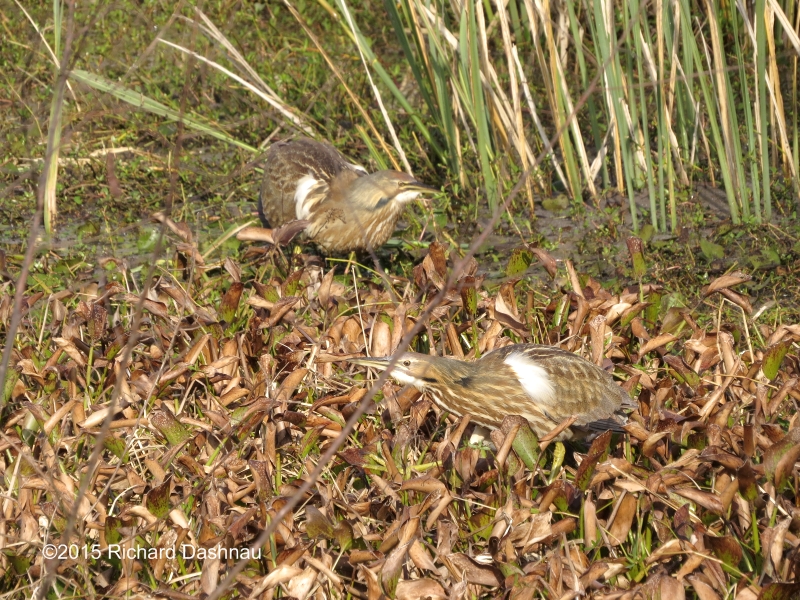
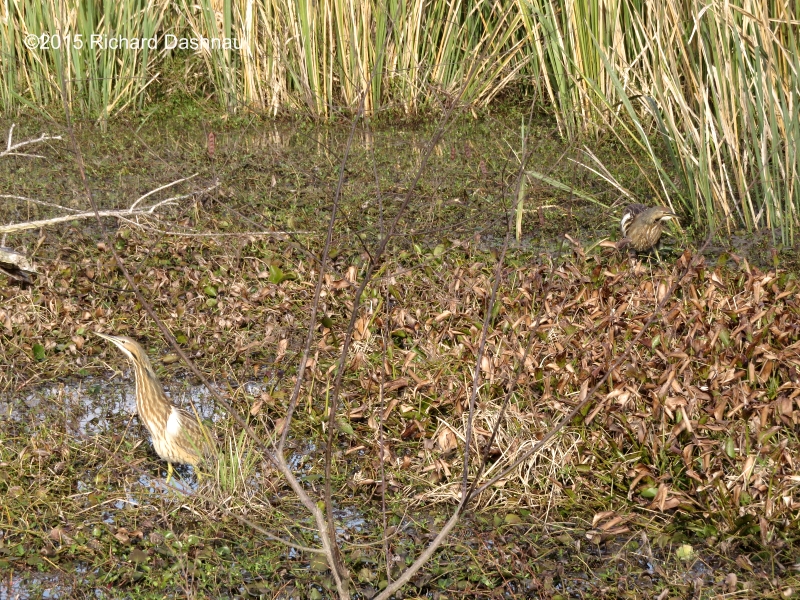
PIC 12
PIC 13
On
February 15th, I was at the 40 Acre Lake parking lot. I was going to
look for the Great Horned Owl nest, when I could hear Bitterns
calling out somewhere over the lake. So, I walked down to
40 Acre lake.
I could hear the distinct call of Bitterns, but they were hiding in the
rice. As I was moving east, towards the Observation Tower, I
heard the "click, click, click" that signals the start
of a Bittern
call. I looked left, and saw a Bittern calling! And I stayed and waited
to see if
it would happen again. And it did call again--and finally, after years
of watching, I was able to see and
hear a Bittern calling quite close,
and shot some video. Bitterns have a very distinctive call.
The three images below
are framegrabs of one of the calls. The video clip
showing 2
different
calls is here: Bittern
Calling (mp4) .
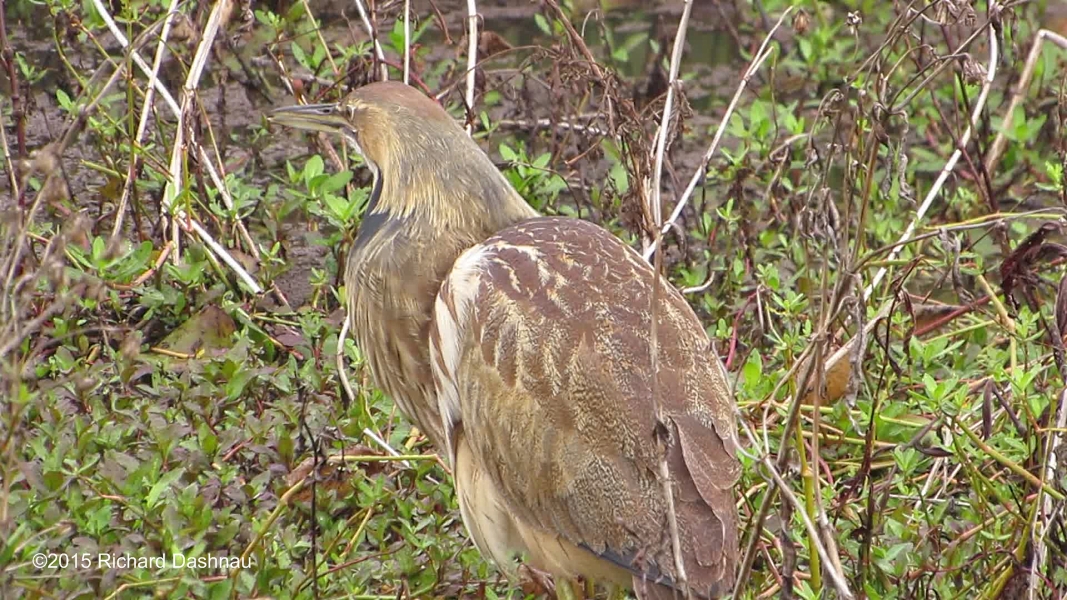
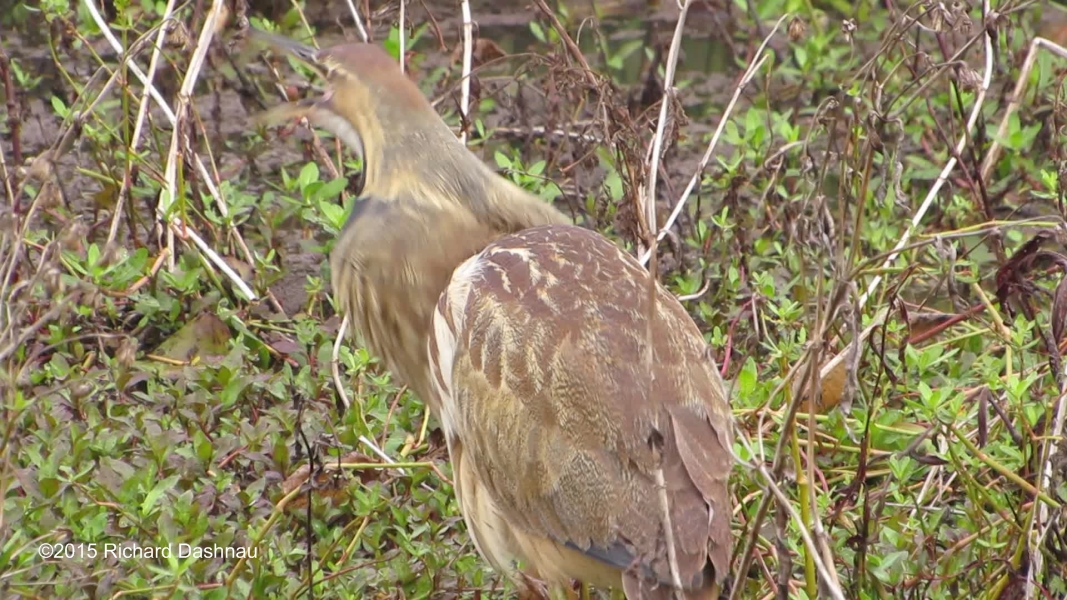
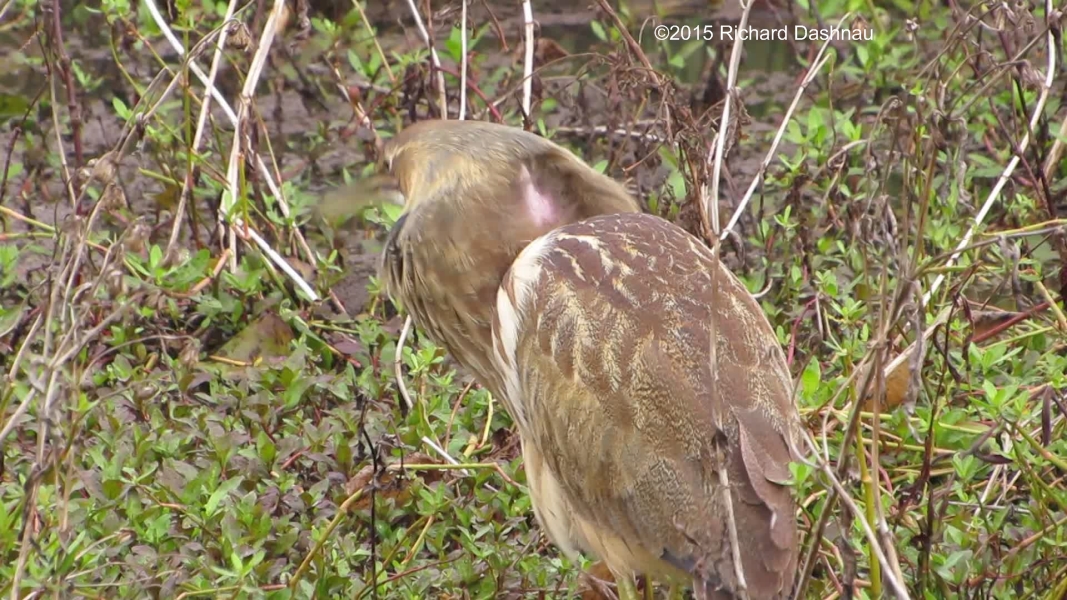
PIC 14
PIC 15
PIC 16
05/26/2012--
There was an Alligator with babies in Pilant Lake along the North
length of 40 Acre Lake trail at BBSP. I was near this group of
alligators when I saw a small, brownish bird come
out of the rice.
I watched it for a while, and I wondered briefly what it was. It was
about the size and shape of a Green Heron...but it was the wrong color.
It was colored similarly to an American
Bittern, but it was too small.
Then, I realized that it was a Least Bittern. This was a surprise,
because Least Bitterns are not commonly seen at the park. I started
shooting pictures quickly,
because the area was getting busy with
people interested in the baby Alligators and I thought the Bittern
would go hide. But, it didn't. So I got to watch the Least Bittern for
a while as it hunted.
The images below are from photos. The brownish
colors (American Bitterns are more green) and the black back with white
stripe are good keys to identifying this bird.
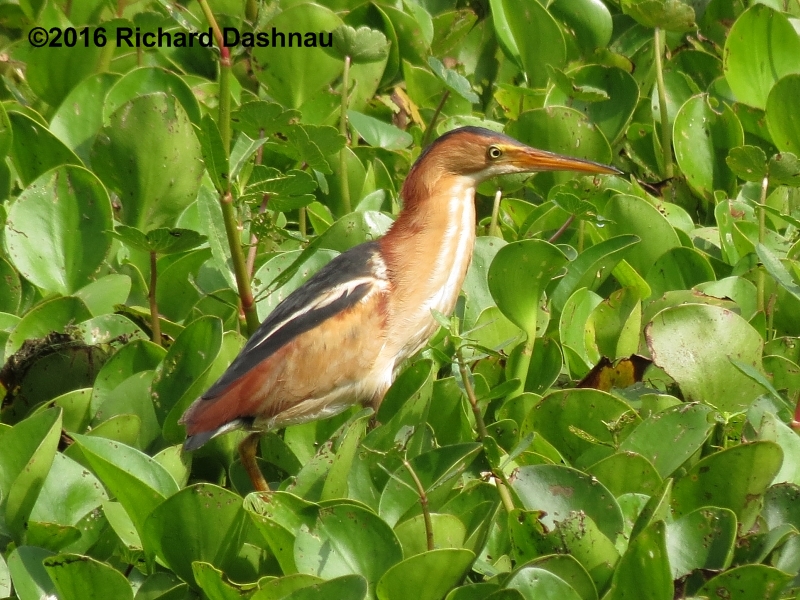 -
-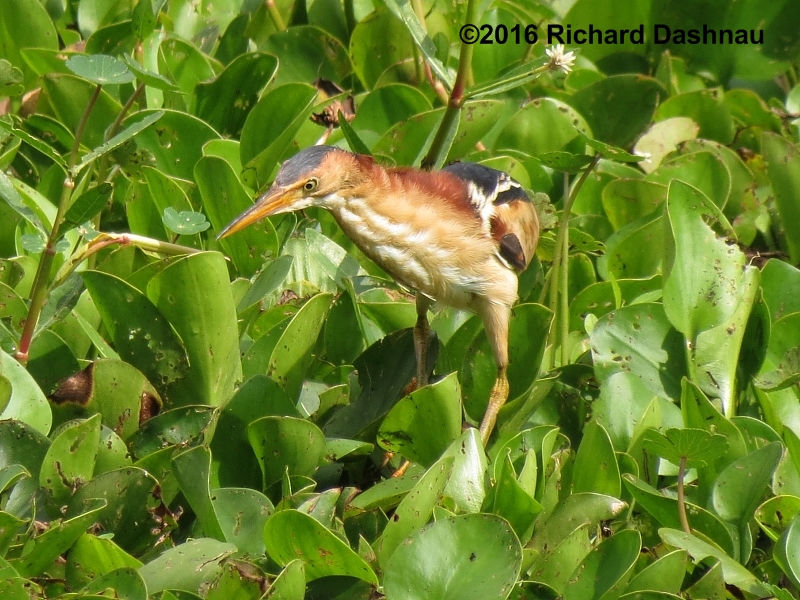
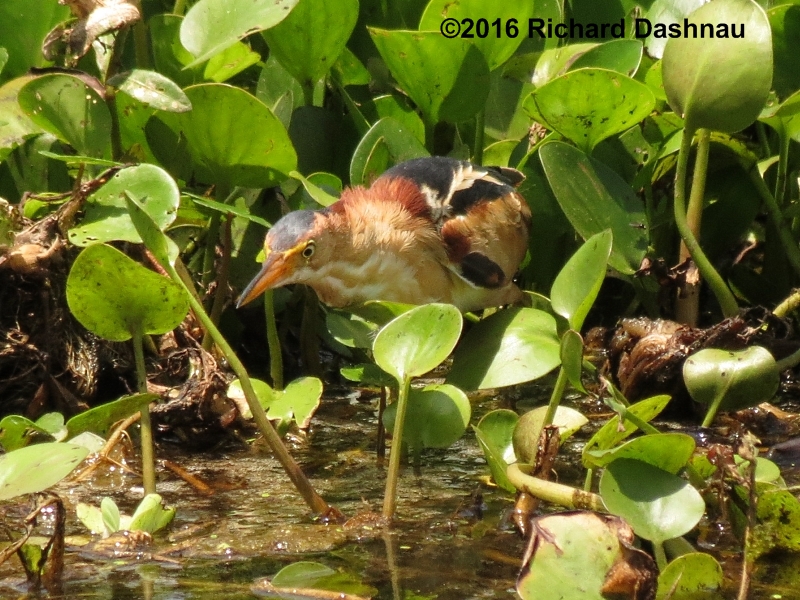
BEFORE
CATCHING FISH
The
picture bottom right is a frame grab from the video that I've put
together from clips I filmed of the Least Bittern as it hunted. I
filmed at 30 and 120 fps. To see the video, click
here.
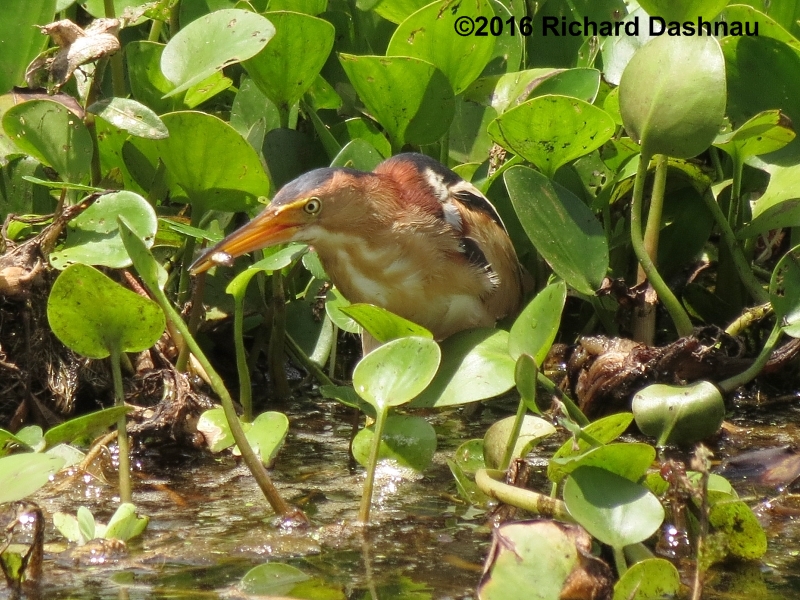
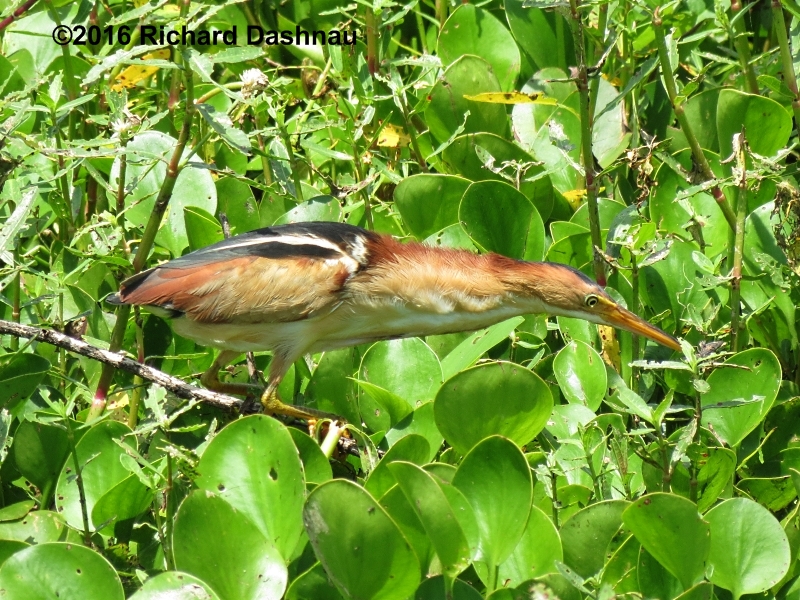
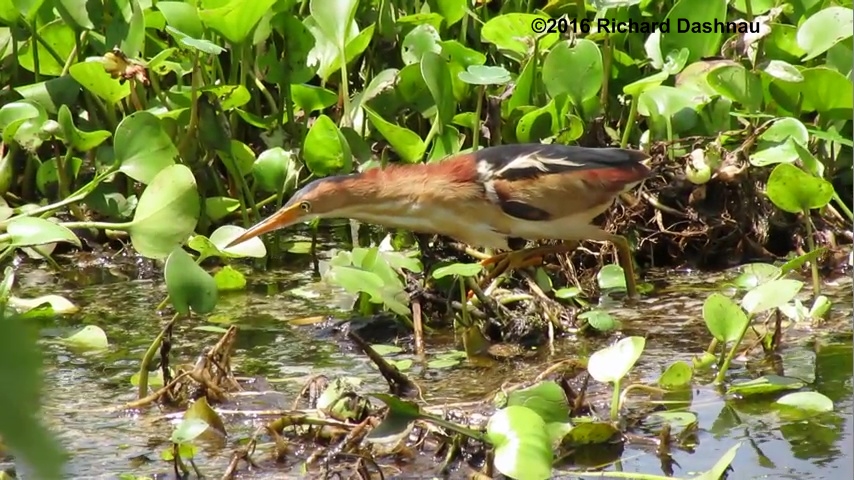
AFTER
CATCHING FISH
02/06/2011-- (added
6/20/2020 I don't know why I hadn't done it before. This is what I
wrote at the time it happened.)
At about 12:30, I was near the Observation Tower at 40-Acre Lake,
watching a White-Faced Ibis and some Bitterns. I was trying to shoot
some interesting slow-motion video clips. I started watching a Bittern
as it moved through the undergrowth about 10
yards from me. I was
waiting for it to get to a clear spot so I could film it. The Bittern
made its slow, stealthy progress through the plants, occasionally
swaying, and sometimes thrusting
down into the wetness underfoot. We've all
seen Bitterns hunting this way.
I
noticed movement a few feet to the right of the Bittern, at about 18
inches high. A Blue-gray Gnatcatcher was flitting at the top of a
plant. The Bittern worked its way in the direction of the
Gnatcatcher,
stalking and looking down. The Gnatcatcher flitted to the top of
another plant, nearer the Bittern. Suddenly the Bittern
looked
up, took two steps towards the Gnatcatcher
(cocking back its head as it
stepped), and STABBED THE GNATCATCHER! I was totally surprised, and
immediately started filming--even though the Bittern was still among
the weeds.
As I watched, the Bittern stalked through the weeds, still
holding the Gnatcatcher, then bent down and...most of what transpired
then was obscured by the plants. But...it looked like the
Bittern
swallowed the entire Gnatcatcher. At this time, the day was threatening
to be overcast--and right at that time a cloud obscured the sun;
darkening the video and hiding what
happened from the camera, too. I
think that most of us understand that Raptors occasionally prey on
birds in the park. Some of us have seen various Hawks or Eagles take
the
occasional Moorhen or Coot. For many of us this is a breathtaking
sight, and one to look forward to. We all understand how harsh the
natural world of eat and/or be eaten can seem.
But this...
...this
was like an assassin's dagger in the back. A total surprise attack. An
act of quick violence. An act of BURDER...most fowl. I don't
have any pictures, but here is the clip that I shot.
I did my best to enhance it.
01/25/2009--
I was walking along 40 Acre Lake trail at BBSP when I spotted an
American
Bittern foraging amongst the plants. I watched it for a while. I hadn't
seen a Bittern at the park for
some time. Then, I shot a few pictures.
Today's RICKUBISCAM is from one of them. I also shot some video of the
Bittern stalking through the grass and grabbing food. I was able to get
a
good sequence of one of the beak thrusts, and subsequent swallowing.
See (GULP!) below. To see the video, click here
(wmv 5.0 mb).
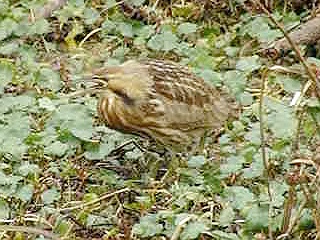 --
--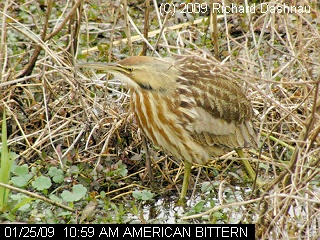
GULP!
RICKUBISCAM 01/25/09
March
30, 2003
Then
there was this American Bittern that I was watching out at the
Creekfield
trail. I watched as it hunted for a while and then, to my surprise, it
waded to shore, about 12 feet
from me (HERE HE COMES, below). Then, he
(she?, I noticed that there were no dark markings around the throat,
which
I believe means it was a juvenile bird), crossed the trail. (See BEEP
-BEEP!,
and MADE IT, below.) Just as he was in the middle of the
trail, some
park visitors came into view behind me. I believe that he stopped to
try
his "vanishing trick" (See, CAN YOU
SEE ME NOW?, below) but he might
have just been trying to get a better look at the approaching
people.
He finally flew off when the visitors got closer.
-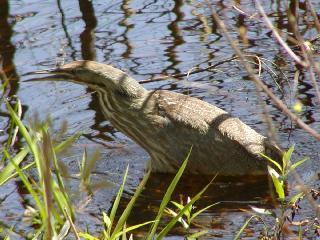 --
--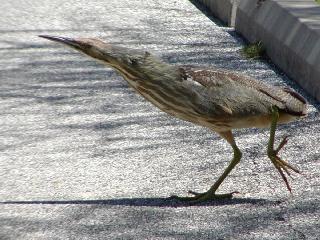 -
-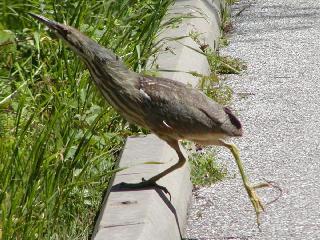 -
-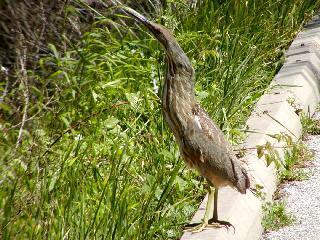 -
-
HERE HE
COMES
BEEP-BEEP!
MADE
IT!
CAN YOU SEE ME NOW?
March
02, 2003
-- --------
--------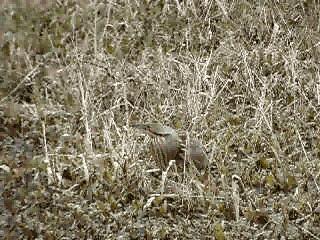 ---------
---------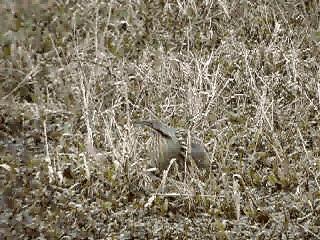
TICK
GLOOP1
GLOOP2
I
was
talking to some park visitors when we here this really odd
sound.
Everyone got quiet, and someone asked "What the heck was that?" I heard
it again, and I guessed that it was an American Bittern,
but I'd never
heard one before. However, Donna (she knows who she is) had described
it
to me, and she'd hit it right on the money. After a little search, I
found
it. The pictures above and below (starting
with TICK, and through
GLOOP3) show frames from a movie clip that I was able to capture with
the
Olympus C-700. The captions are how I would describe the
sounds I
heard him making. Gloop 1-3 are
three stages of a single deep sound.
Of course, I'd only intended a quick trip, so didn't bring my video
camera.
Click the following links for two flv video clips of the Bittern
calling
clip1(656
kb) clip2(654
kb).
He was about 30 yards away, and blends in with the grasses, so the
resolution
isn't that good. I've also included an .mpg
(2,619 kb) file of the second clip that's a little clearer (but much
larger!).
One never
knows what one will see at this park. The last image (AMERICAN
BITTERN) is a little better photo I was able to get as he was walking.
UPDATE,
01/04/2014: In an effort to update the pages to be better visible with
today's (2014) internet speeds; I have been expanding the sizes of the
pages. Along with this, I will try to post better
(upgraded) video
clips whenever possible. Unfortunately I will not have the
original
video files for some of these. For others, I will only have the digital
video that I shot at the time. If I can, I will "remaster"
these video
clips to a larger size. Here are the two video clips referred to above,
remastered to a somewhat larger size (480 x 360). clip 1 (wmv 3.1mb) clip 1 (mp4 3.9mb) ; clip 2 (wmv 3.0mb) clip
2 (mp4 3.8mb)
-----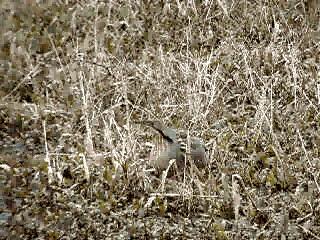 ---------
---------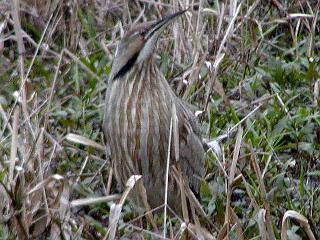 ----------
----------
GLOOP 3
AMERICAN BITTERN
January
10, 2002
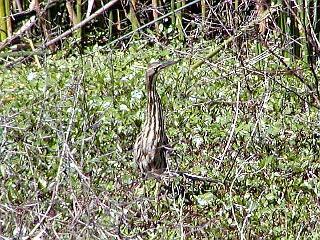 -
-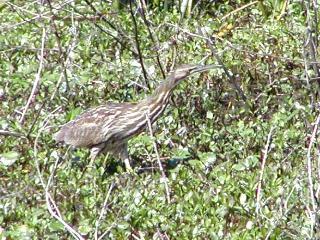 -
-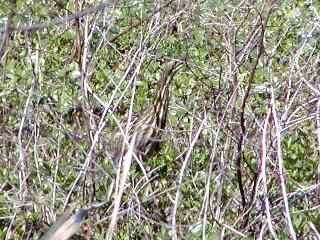 --
--
AMERICAN
BITTERN 1---
---
AMERICAN
BITTERN 2---
-----
AMERICAN
BITTERN 3-
----
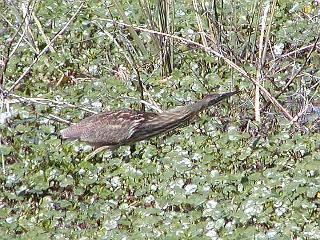 -
-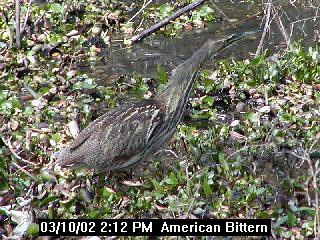
AMERICAN
BITTERN 4
---
-AMERICAN
BITTERN 5
The
images above (bittern) show an American Bittern,
which is usually
a shy bird, and rarely seen. I think part of the reason for this is its
amazing camouflage. I was taking pictures of this one,
and trying to show
it to some park visitors and they had a hard time seeing it. Click here(mpg
1,681 kb) to see a short movie of this bird, and you'll see
what
I mean.
If
you'd like to know more about the park
follow these links:
Brazos
Bend State Park
The main page.
Brazos
Bend State Park Volunteer's Page The
volunteer's main page.
Go back to my home page, Welcome
to rickubis.com
Go
back to the RICKUBISCAM
page.
Go
back to the See
the World
page.








































































































